Build, accumulate, attack, repeat: real-time strategy history
- Transfer
While we are waiting for the release of the new Age of Empires this fall , let's recall the ups and downs of the RTS genre.

The rise and fall of real-time strategies was very strange. They arose gradually from experiments in which developers tried to combine the speed and interest of action games with the deliberation and depth of strategies. Suddenly, the genre gained explosive popularity in the second half of the 90s, and then just as quickly lost it (with the exception of StarCraft ) in the mid-2000s, amid stagnation and changes in the game market. However, one of the most popular competitive games in the world is RTS, and the three of the four remaining are an offshoot of the real-time strategy genre.
At the age of 25, real-time strategies remain committed to their basic ideas and legacy. Today, at the moment of a deep lull of the genre, it's time to historically explore it, as we did with graphic adventure games , Sim games , first-person shooters , card races , open-world games ( translation into GT) and city-building simulators .
Before starting, I’ll explain: as in all studies of the history of genres, I want to highlight innovations and new ideas, that is, I can bypass some popular games and not mention at all [here is the name of your favorite game]. In this article, real-time strategy means the one in which the base is built and / or managed, the collection of resources, the production of units and semi-autonomous battles, and all this happens in real time (and not in turn-based mode). The aim of the game is to capture / hold strategic points of the map (for example, resources and command centers).
I also want to emphasize that tactics and strategy are not the same thing, and therefore in this article almost no tactical games in real time will be considered , for example, Total War and Close Combat. If you don’t know: strategy is high-level planning, and tactics are focused on smaller tasks. If to explain in terms of video games, the strategy is the construction and management of the armies created in the buildings with the help of the extracted / collected resources; tactics apply only to the battle itself and deep-seated combat mechanics, focused on the alignment and deployment of troops, the use of terrain features. RTS usually has an element of tactics, but tactical games rarely have strategic mechanics.
So, taking into account all of the above, let's begin the journey 36 years ago into the past.

If you recognize this game, then you have found the birth of the genre ( Utopia ).
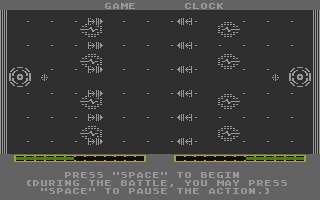
Cytron Masters for Atari.

Perhaps the graphics are not impressive, but the mechanics of the game were advanced at that time.
The separation of strategies into “real-time strategies” and “turn-based” strategies has been introduced relatively recently. Until the mid-90s, strategy games were turn-based, and action games were played in real time, and they never (well, almost never) combined. The game design was based on incompatible ideals: strategies inherited the rich traditions of complex and intricate desktop wargames; the action was a simple and thoughtless test of reflexes and coordination, they were based on arcade machines. The strategy was methodical and unhurried, dedicated to carefully planning and weighing each decision. The idea of adding real-time elements to force players to make instant, impulsive decisions was unheard of. Moreover, she seemed to be completely the opposite of strategy.
But it was at this time that Don Daglow created the highly influential 1981 Utopia game for Intellivision, which was one of the earliest predecessors of the real-time strategy genre. Utopia talked about the war of two island nations, in which it was necessary not only to penetrate the territory and / or destroy the enemy, but also to create their own reliable and prosperous base. It was necessary to think about the infrastructure, production, troops, weather, spies, pirates and the results of player decisions. As if it was not complicated enough, life on the islands and between them continued to boil even in the minutes of downtime - pirate raids, hurricanes, crop failure, riots and much more.
Soon, other “action-strategic" games appeared, each of which had its own view of how the two types of games should be combined. The next notable game was Cytron Masters (1982) from recognized designer Dan Bunten (later known as Daniel Bunten Berry). Bunten later said that the game "fell into the crevice" between the players in action and strategy. (Note: In 1992, Bunten changed sex and called himself Bunten Berry.)
Cytron Mastersthe gameplay resembled an early prototype of the RTS concept, but despite this, it failed commercially. The game had five semi-autonomous classes of units engaged in defense, attack and communication on the battlefield, several power sources that gave more energy (the only resource of the game) and allowed to build more units. The whole process took place on one screen. Players started the game on one of the edges of an area similar to a football field, but instead of the goal there were command centers. Players could see how the commands given by the adversary are executed in real time, along with their own.

Nether Earth

Robots \ m / appear in the RTS genre.

Modem Wars .

Stonkers .
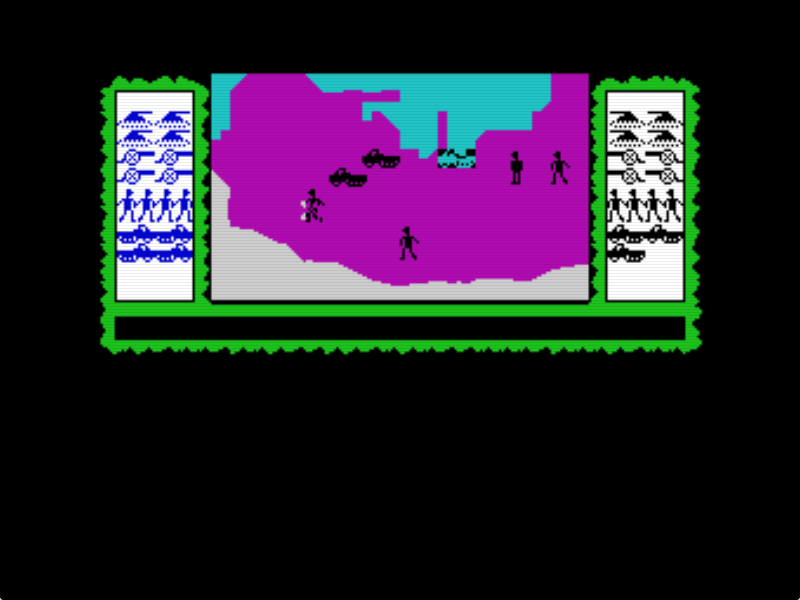
Wargame for the ZX Spectrum Stonkers (1983) andChris Crawford's Legionnaire (1982) sought a more action-tactical style of play. The stripped-down quick adaptation of the combat phase of the traditional real-time wargame with beautiful Stonkers graphics was met with great enthusiasm, but many interfering game bugs negatively affected sales. Legionnaire , a simple semi-historical simulation of the battles of the Romans and the barbarians, received a more controversial trick. This game became the progenitor of the genre of real-time tactics (RTT), but he had to wait for popularity until next year. Then The Ancient Art of War appeared , a hit and influential computer wargame (RTT, like its closest relative RTS, took many years to finally become a recognized separate genre).
MeanwhileNether Earth (1987) further consolidated the basic concepts of what would later become RTS. In it, the player creates robots that can capture or destroy the six types of factories necessary for the manufacture of components used to produce even more robots. The ultimate goal of the game is to destroy the enemy’s base / bases, erasing them from the ground with the help of nuclear weapons aboard the kamikaze robot. The player can control the robots himself, choosing them one at a time, but usually it’s better to just give them orders to destroy, capture, kill or defend, and to focus on making new robots to surpass the enemy.
Another Dan Bunten Game Modem Wars(1988) put more emphasis on tactics, but possessed many of the elements that over time became critical in real-time strategies. Including the fog of war, which does not allow you to see enemy troops outside the scope of a unit / building, espionage, variable unit structures, the effect of terrain on movement and battle. The power-packed pace of the game made it possible to cope with many tasks without overloading the player (many of the later RTS were not able to learn this lesson).

Herzog Zwei
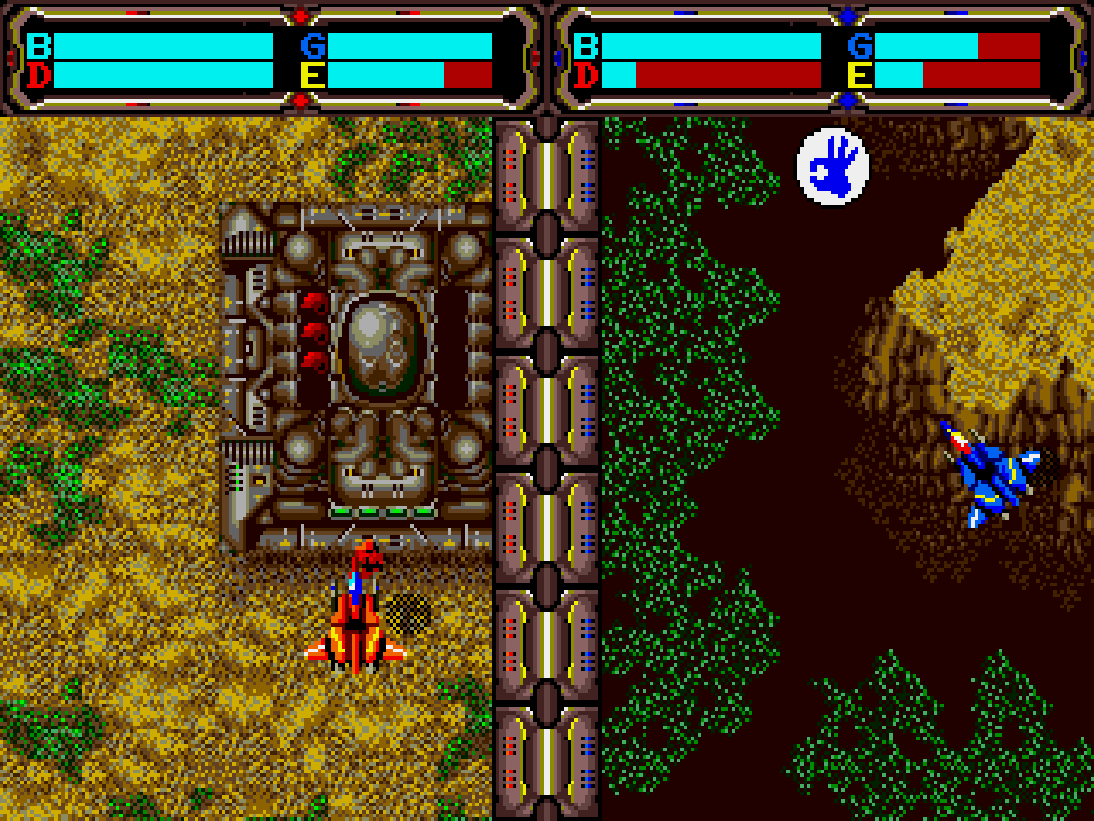
The player controls one of the fighting mechs, each of which can take air and ground forms, as well as carry different types of units. Units can be bought at the command center and give them orders.
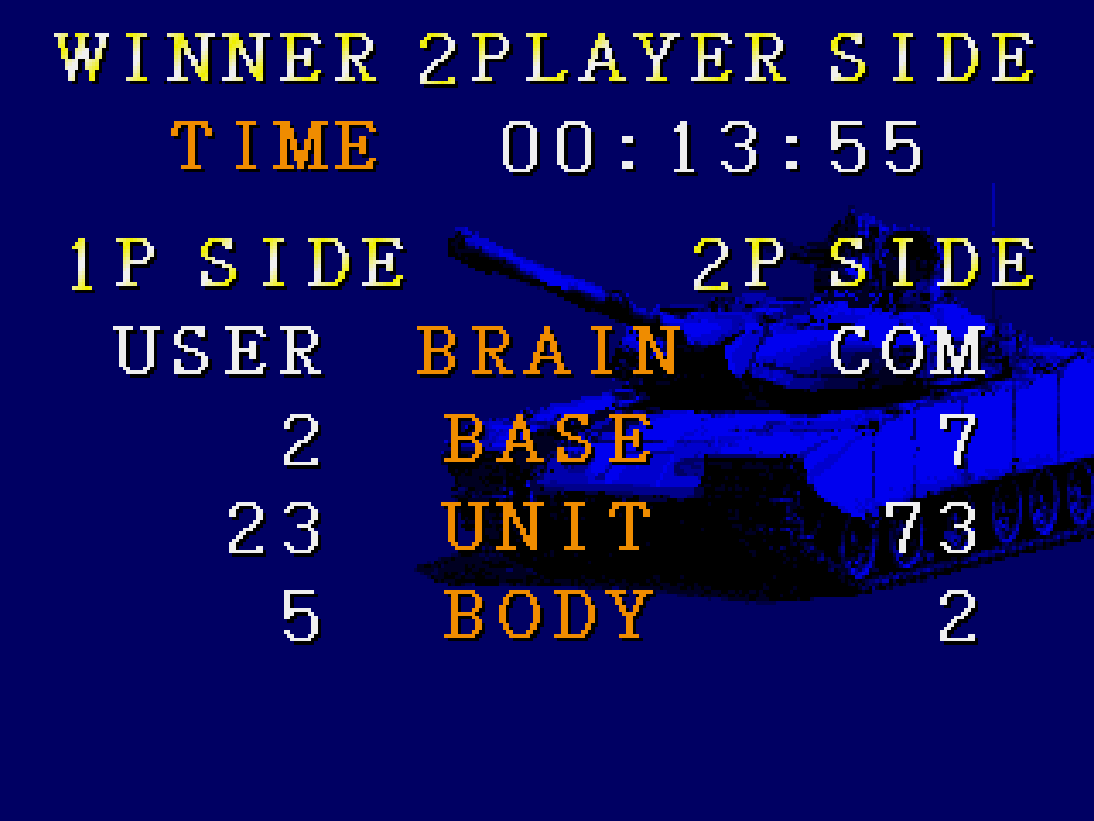
Get it, player 1.

Powermonger for Amiga.
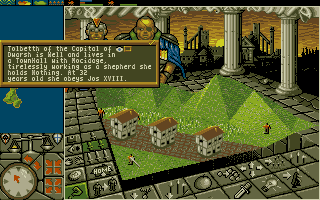
Click on objects and read descriptions.

Command HQ .
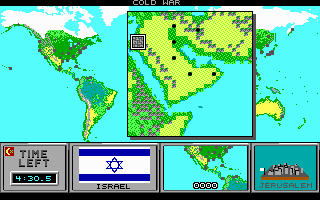
This game is similar to the RT adaptation of the classic Risk board game . It allows you to zoom in on the map and explore the cities of the country.
In the same year that Modem Wars came out , the tactical fur shooter Herzog of the Japanese Technosoft studio laid the foundation for what many consider the first real-time strategy game. After her in 1989, Sega Genesis released a prototype of MOBA (multiplayer online battle arena, the RTS offshoot genre) Herzog Zwei . In it, you control one of the fighting mechs that can transform between air and ground forms, as well as transfer different types of units that you can buy at the command center. You can order units to patrol, hold a position, attack / capture a satellite base, supply other units with supplies, or attack the enemy’s main base. Units try to complete these tasks with or without player assistance.
Nine satellite bases are scattered on the map, each of which can be captured with the help of four infantry units. Bases generate money, that is, they allow you to quickly release new units. In addition, bases can execute orders for the purchase of new units.
It was a difficult game, even despite the boring AI. Already at a low level of difficulty when playing against a computer, it instantly moves around, captures empty satellite bases, and then bumps into your main base with an endless crowd of units. Herzog zweiremained chaotic even when a player adjusted to her pace. When your units gained an advantage, the enemy could intervene with their fur and quickly destroy them if you do not support them with your own fur. But every second of participation in a battle is a time when you cannot buy new units, so the game turns into tedious exercises for quick micromanagement. Probably, the game foresaw the almost inevitable after StarCraft of the future multiplayer RTS - a world in which minor errors can have devastating consequences, and delay and power means a loss.
But at a time when the genre was just getting on its feet, the main task was to outline the basic mechanics, which varied greatly in different games. The next was Powermonger(1990) from the developer Populous Bullfrog, which almost redeemed its monotonous gameplay and stupid interface with interesting ideas. The game had a polygonal 3D map with the ability to scale and rotate, but limited to a small field of view. It had interconnected elements of simulation, such as wild animals, changing seasons and urban residents with their own activities that influenced the world (for example, there was less food in winter). The game was attended by interesting touches - in the cold, people basked near the fire, and after death turned into angels.
Also in the game there are three “build” armies that affect the execution of orders. Under suitable conditions, you can force all people from the conquered city to join your army, taking any available weapons, although it is often better to leave part of the inhabitants in place so they can work (thus providing you with the supply of resources for recruits if necessary).
Game Powermonger comes on the heels Command HQ Dan Bunt (1991), which appeared as an adaptation of the classic board game Riskin real time. It made the player scamper around the menu, managing the economy, helping foreign countries, studying intelligence reports, buying and placing units, setting targets for attacks, exploiting oil fields, launching space satellites and fighting in other world war simulations, from first to fifth. Sensible Software,
completely different in style and presentation, but equally ambitious on the scale of Mega Lo Mania (1991), stretched throughout the entire human history, divided into 10 eras. Like Powermonger , she lacked the tactical component of the battles, but she made up for it differently. At Mega Lo Maniathe player must assign people tasks: researching new technologies, collecting / extracting / processing the resources necessary to obtain better weapons, giving birth to new people or expanding the army. It was not only a technological, but also a territorial game in which the player had to send his troops to destroy enemy bases and / or build new fortresses in other areas. (There were different resources in each area, so sometimes it was necessary to reinvent / research the same technology.) The
uniqueness of the world and the small computer men made it possible to close our eyes to the shortcomings of Powermonger. Playing with small touches improved various aspects of the gameplay, except, it may be uninteresting and monotonous final phase. It is worth noting the beautiful voice samples transmitted with excellent intonation - “We've nuked them!” and the stereotypical “Do you want to be in my gang?”. In addition, after reaching a new era, buildings and people changed their appearance.

Dune II .

This game came out shortly after the original Dune , and both were very loosely connected to the film.

Of course, whoever controls the spice owns the Dune universe .
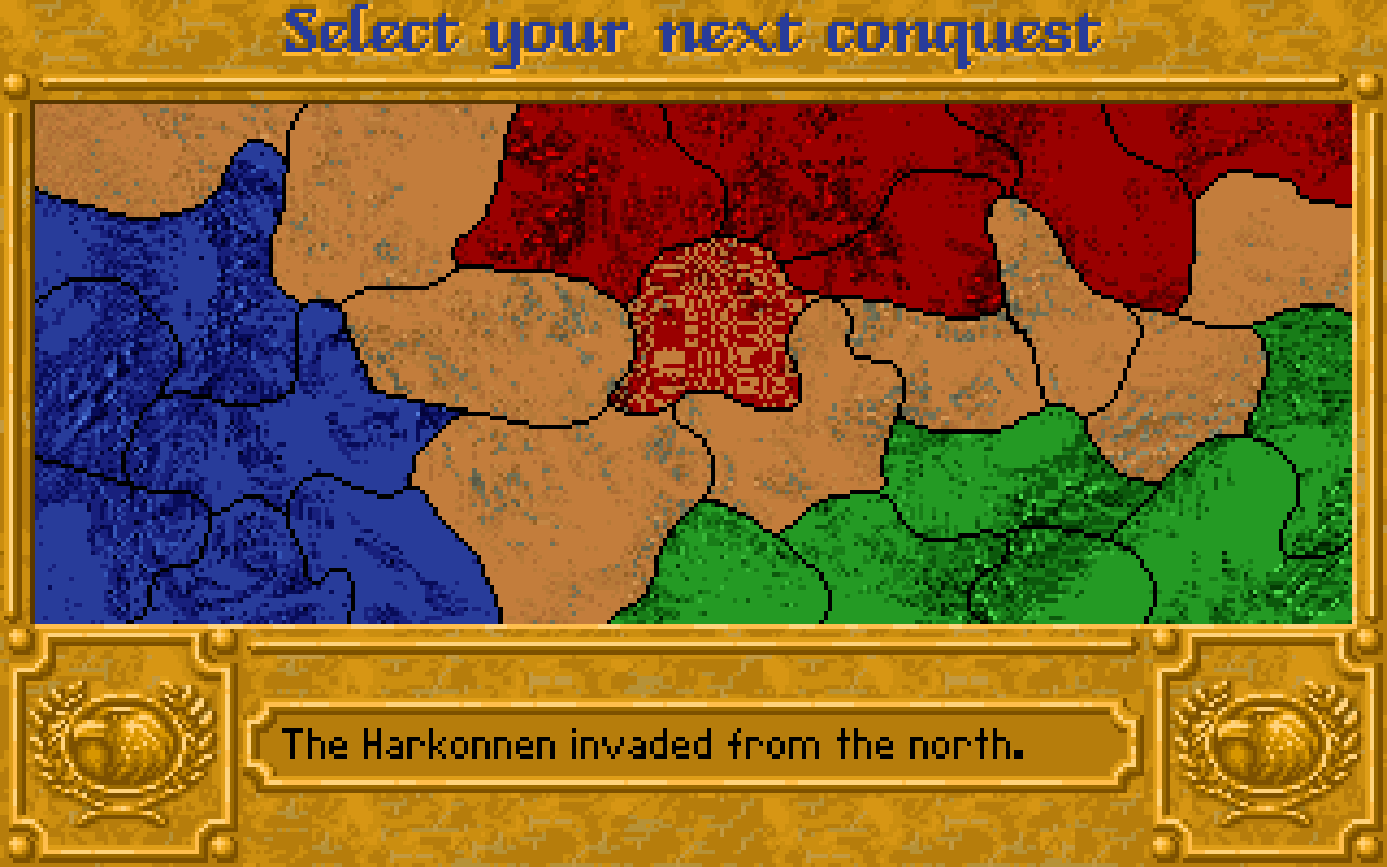
The North caused problems long before the era of Game of Thrones .
Only in 1992 did real-time strategies gain their name thanks to Dune II producer Brett Sperry, who coined the term in an attempt to describe his game. From a design point of view, the Dune II was a little more than just an improvement on previous work, but their legacy and influence were evident throughout. Dune II is the first RTS game that people usually remember. This is a game that determined everything that arose after, both good, alas, and bad.
The developer of Westwood Studios, previously known for the most popular RPG Eye of the Beholder , when developing a superficially related to books and film Dune was very inspired by Herzog Zwei , the god simulator Populousand Macintosh GUI with mouse controls. Dune II , strangely released just a few months after the adventure game Dune Cryo Interactive, tells the simple story of House Atreides, House Harkonnen and invented by the developers of House Ordos, who are fighting for the control and use of spice on the planet Dune, because, as everyone knows, at least superficially familiar with the world of Dunes, the one who controls the spice controls the universe.
There is something undeniably exciting in the Dune II base gameplay- you send a harvester to collect spice, turn it into loans for which you can buy upgrades, repairs, new units and new buildings. A more convenient interface allowed less mess with micromanagement during attacks by enemies. This meant that the player had more time to study the map, create additional bases and think over strategies for destroying the enemy. During the game, you understand that with each passing minute, computer-controlled enemies also gather resources to improve the base and strengthen their army. This promised a long, exhausting battle for the capture of the map (it further worsened its need for a constant “click” to give orders separately to each unit, because there were no options for grouping or choosing several units).
Westwood took a feedback loop from the genre, which in the preliminary review of Computer Gaming World magazine's Master of Orion in 1993 would be named 4X (eXplore, eXpand, eXploit, eXterminate), and found a winning formula by changing the scale of the strategy from macro to micro level. In essence, each level was a small-scale 4X battle in real time.
The player always starts with a construction base, several hundred credits and a couple of units. Then, having restored its base after the attack (it is most convenient to do this by protecting at least one spice processing plant and mobile construction vehicles hidden in a safe place), he continued development - he created a second spice plant, ideally located near the distant spice field, monitored the enemy’s movements on a mini-map, built reliable (directed towards the enemy) perimeter defense away from the center of the base, sent trikes to look for weak spots in the enemy’s defense, at the last levels he built space sky port (because it is a cheaper and faster way to get the necessary tanks and missile launchers than a heavy machine factory). Another element of tension was the natural time limit - the amount of spice remaining. If you run out of spice before you win, then this is a sure sign of defeat. So modern RTS were born.

Maybe Dune II gave the name to the genre, but WarCraft stole it.
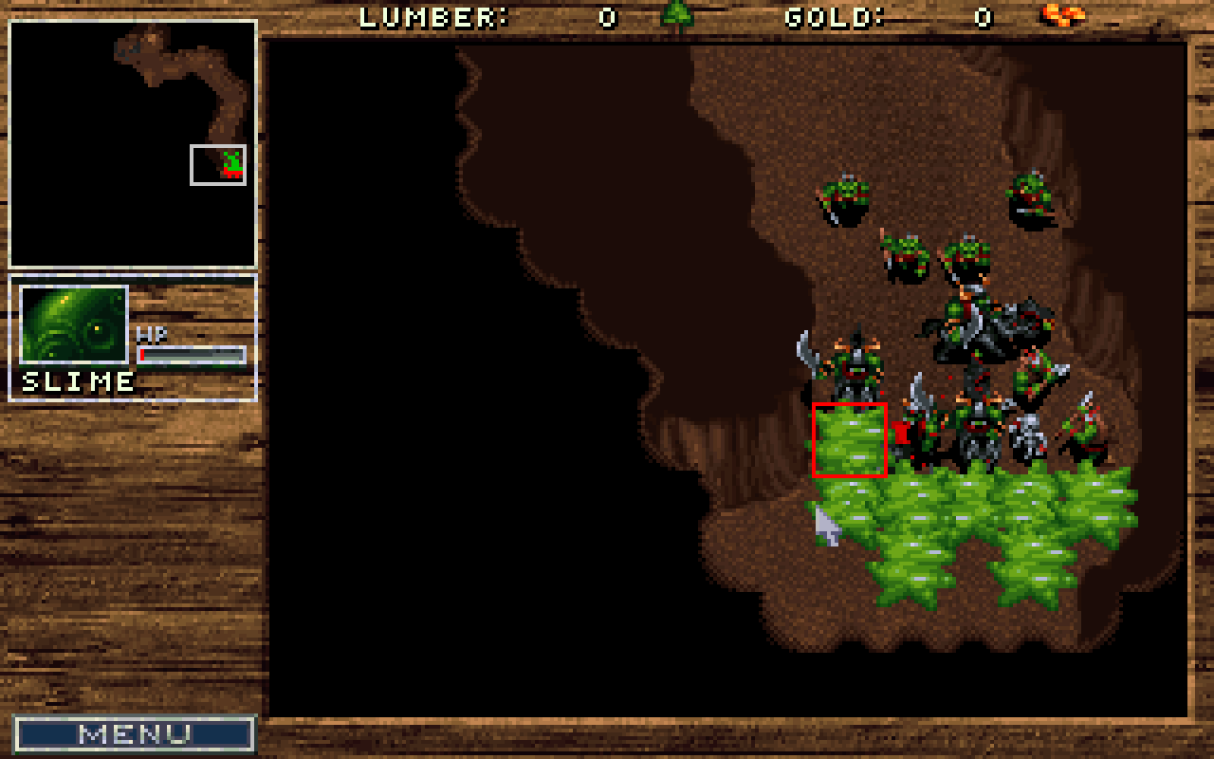
Not every game of the RTS genre of the DOS era could inspire the creation of a film adaptation.
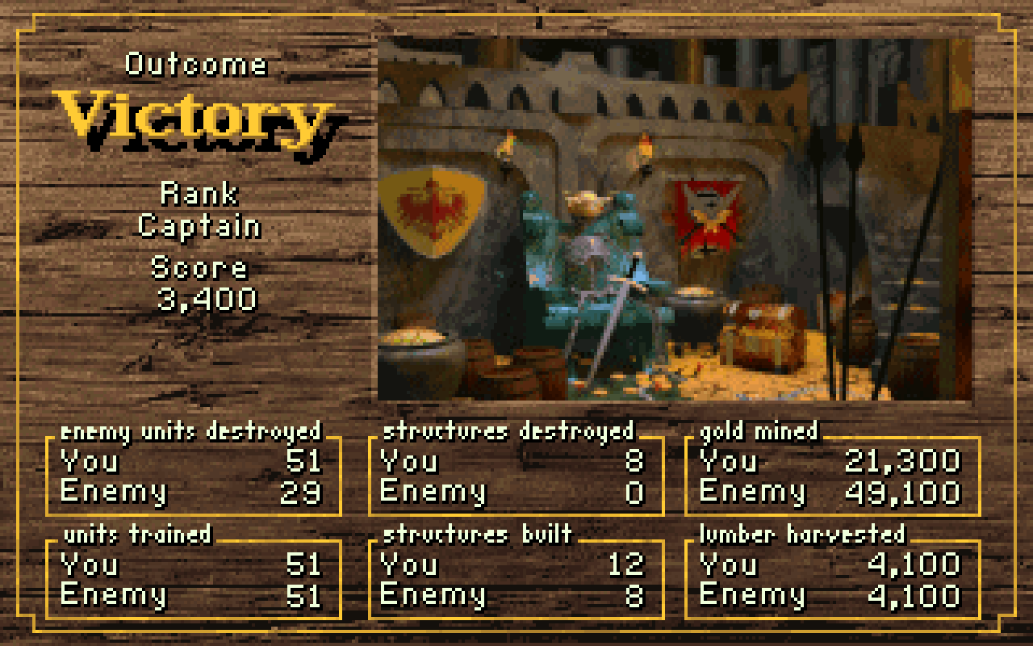
V means Victory.
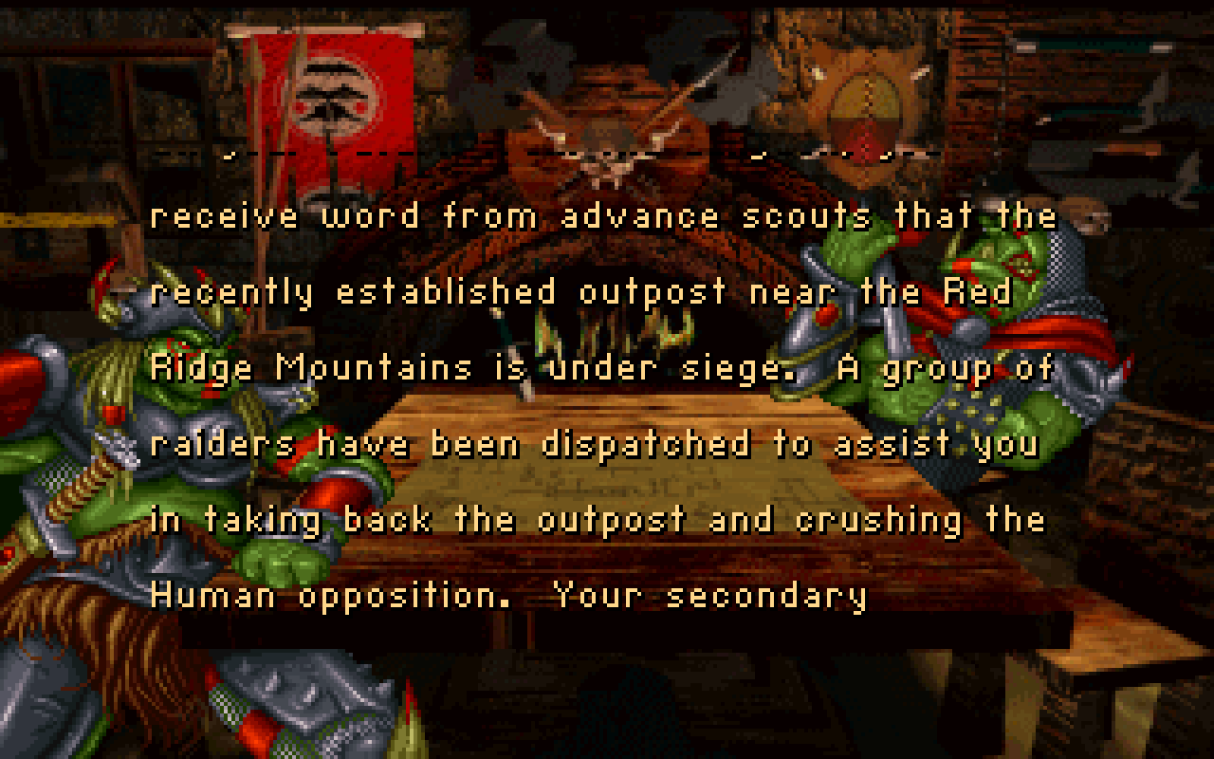
Everyone likes a good orc.
Then (then) the little-known studio Blizzard Entertainment consolidated the Dune II format as a new genre. Warcraft: Orcs and Humans (1994) replaced the sci-fi entourage Duneon old fashioned fantasy. Now the player did not collect spice to receive money, he mined gold and felled trees. Buildings were not built out of sight and were not exhibited instantly; they were built in front of the player’s eyes by unarmed peasants / peons, who also needed to be created (or, rather, “trained”).
In addition, the two warring races of Warcraft had their own personality. If Dune II’s Dom Harkonnen showed his villainous nature only with the destructive power of the Death Hand rocket, then the Warcraft orcswere charismatic and strangely attractive both in the game itself, where they answered the player’s orders with phrases, and in cutscenes between missions (a text scrolling with a comic voice acting against a static image), even when an orc girl was ordered to kill another orc (in order to “teach” her obey father).
In Warcraft, there was also a two-player battle mode for a local or Internet connection on maps used in the campaign or created procedurally. As the popularity of Doom defatch matches has changed first-person shooters, so the multi-user RTS mode has led to a gradual shift in development priorities. Warcraft Multiplayerwas popular and fascinated players even when they fully mastered the campaign for orcs and people. For Blizzard, this was an important lesson.

Command and Conquer .


The Cursed Brotherhood of Nod.
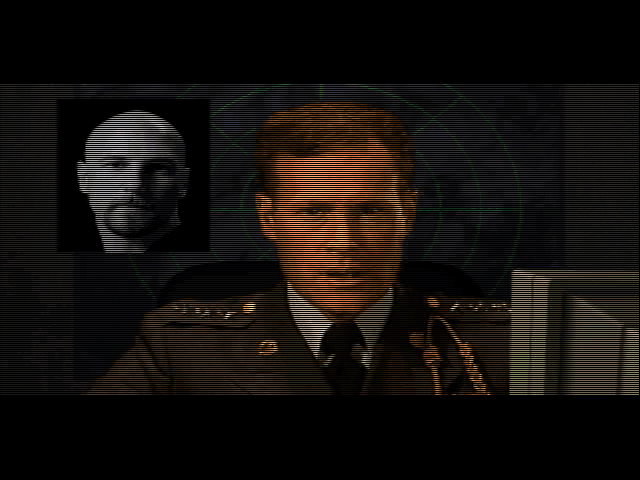
These are unforgettable videos.
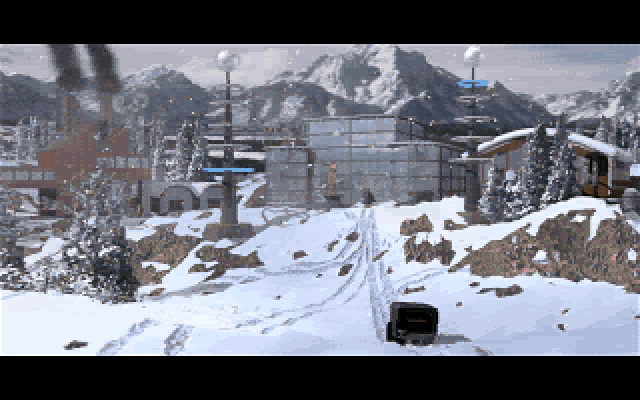
Alert of Red .

The node and delightfully played video scenes are back.

What is the background of Red Alert ? The plot begins with the fact that Albert Einstein returns to the past to kill Hitler ...

Warcraft II .

The game added the mechanics of the fog of war, which made a great contribution to the RTS genre.
Westwood learned her own lessons from Dune II’s spiritual follower , Command & Conquer (1995), an exaggerated, frivolous view of the alien substance war between the Global Defense Initiative (GDI) and the Brotherhood of Nod, decentralized paramilitary secret community with deep corporate ties and almost cultist zeal.
At its core, Command & Conquer has become a faster version of Dune IItransferred to the alternative timeline of our world. It was supplemented by notable innovations - the choice of several units, support for multi-user mode and a logical interface. But one cannot stop on this description, otherwise we will neglect all the brilliance of other elements of the game. The deliberately pompous melodramatic cutscenes featuring live actors against the backdrop of green screens brought a bizarre fun to the dark theme of the game. It seemed that the GDI forces always act according to circumstances, the Brotherhood of Nod has become so cliched manic evil that it was impossible to resist laughing, watching their plans, betrayals and unjustified violence.
Nod’s troops readily kill defenseless inhabitants and destroy their homes, both during missions, if you do not defend the village, and in cutscenes. In one noteworthy mission for Nod, you are ordered to partake in the immoral philosophy of the Brotherhood: steal a GDI helicopter and then destroy a nearby village. But all the fun does not go to only Nod soldiers: in the campaign for GDI there is an amazing mission, in you use the commando to wipe the enemy base off the face of the earth, by secretly setting up explosives around it. Commando became one of the coolest units in RTS, in particular, due to the fact that they accompanied their destructive and bloody actions with gloomy phrases like “I have a gift for you!” and "One left!" Command & Conquer
Seriestook its place in pop culture thanks to the 1996 spin-off in the theme of World War II Red Alert . He transferred the wonderful videos, the fast pace and the spirit of the 90s of the original game into an alternative story of the mid-20th century, which in some way even better matched the style. In some ways, it can be considered a prequel to the frivolous first game. The story begins with the fact that Albert Einstein is transferred back to the past and kills Hitler, and this leads to absurd consequences - the Soviet Union has its own views on the expansion of territories, therefore an alternative World War II begins in which you can participate on the side of the Allies or Soviets .
Of course, the Nod Brotherhood could not do without the Brotherhood either - its mysterious leader Kane takes part in backstage intrigues in the corridors of Soviet power. In the game, the Tips are not as sinister as the Nod forces in C&C , but they can still please sadists thanks to weapons like Tesla’s coil, which can instantly fry any unit that’s unlucky to be in its field of action. Red alertIt is also noteworthy that the differences between the warring parties have intensified - the Soviet and Allied units differ more in skills and capabilities than the strength of Nod and GDI, despite the fact that at that time the trends in game development went in a different direction. However, the developers didn’t implement this quite correctly, so instead of taking advantage of variability and variety, ambitious players quickly found the dominant strategy: play for the Soviets, build a lot of heavy tanks, and then arrange a “rush” at the enemy’s base.
At the same time, Blizzard consolidated the success of Warcraft with the sequel to Warcraft II: Tides of Darkness (1995) with improved graphics and controls. Now the player could select several units in the same frame as in Command & Conquer, and the indicators and capabilities of the selected unit were visible at a glance. An added convenience was that the player could choose whether units should hold positions, chase attackers or patrol territory. Also in Warcraft II there was a deeper plot, in addition, for the first time in the genre, the game added a two-level fog of war system: not only unexplored areas were covered by black fog hiding everything, but areas outside the visibility of the player’s units and buildings (or his allies) were obscured grayed out. The player could still see the terrain, but not the enemy actions hidden by this fog.
The mechanics of the improved fog of war have changed the face of the genre. It meant that you could never have complete information about your enemies, which added many new levels of strategy. Now it was possible to suddenly make stealth attacks, fast and farsighted units could be used as scouts after the initial stage of the map research. And if the enemy is careless in intelligence, then you can accumulate large reserves of units hidden from his view, and then lure him into a trap. RTS games were still competition in click speed, but this innovation showed that they are beginning to justify the word "strategy" in their name.
After two hit Warcraft games and the resounding success of the three RTS Westwood, gateways opened - real-time strategies got into trends. And hordes of clones appeared.
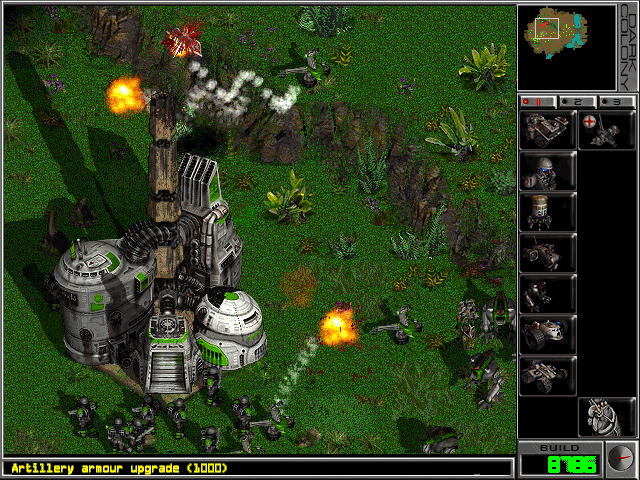
After the appearance of excellent RTS, which attracted the attention of players, the creation of mediocre games was only a matter of time ...
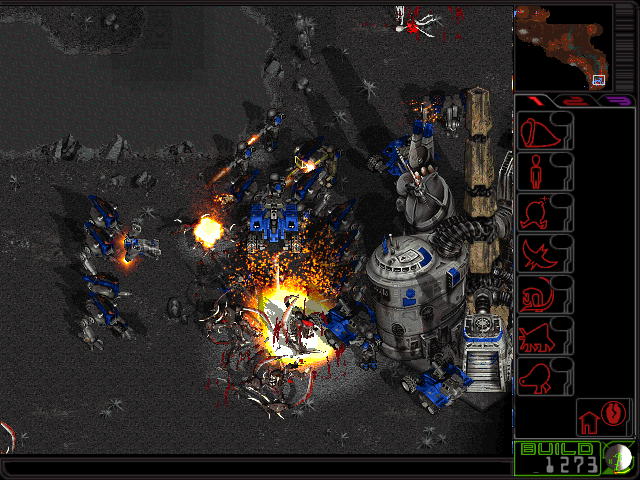
such as Dark Colony ...

... or Earth 2140 .
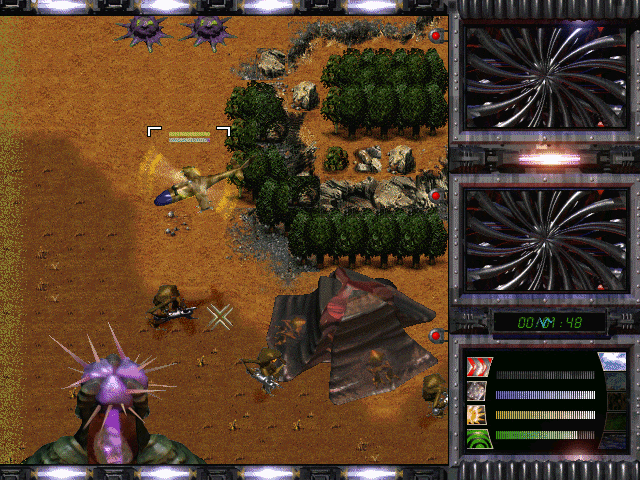
Conquest Earth .
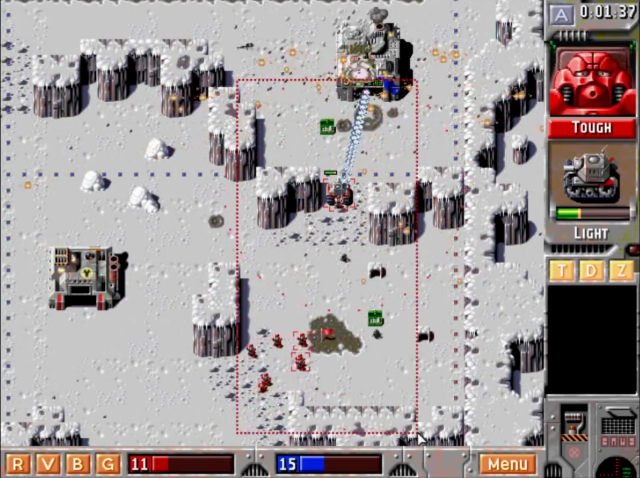
The best example from this stream of the second half of the 90s was Z (pronounced “zed”).
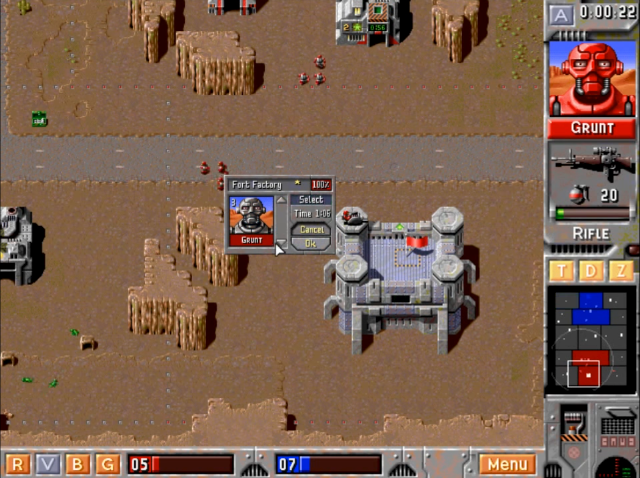
The game had a single tempo option - swift. It was a continuous crazy sequence of quick ups and downs in the battles for domination.
In this emerging abundance of mediocre science-fiction RTS Conquest Earth(1997) stood out because it allowed the race of Jupiterians attacking the Earth to disguise themselves as map objects, human transport, and also combine several weak units into one powerful one. Released in the same year, Dark Colony included a hero-like unit commander and mystical artifacts that could be captured to gain an advantage in battle. For example, you could turn surrounding trees into weapons or suck enemies into a tiny black hole. In Earth 2140 , also released in 1997, generals appeared who had special skills in managing and organizing groups of units, but they were so stupid that they turned out to be a burden rather than an advantage.
The legendary British studio The Bitmap Brothers, which was adored by Amiga fans for games of the late 80s and early 90s, managed to stand out from its competitors thanks to the 1996 game Z (pronounced "zed"). Instead of cultists with megalomania or warring races, the game told the story of armies of space-traveling robots programmed to battle to the last for control of five planets. The game added to the genre of British eccentricity, combining the humor of projects such as Mega Lo Mania and Powermonger with the irony that arose over the previous few years of the development of RTS.
Zbecame one of the first RTS games in which there was nothing superfluous. There is no slow construction, no temporary lull in the middle of the game, no tedious battles at the end of the level - only a constant crazy series of quick ups and downs in the struggle for domination. It was a game about territory control with simplified systems for collecting resources and managing bases. Their place was taken by control zones: the card is divided into cells, and the game itself resembles the RTS version of the “flag capture”. It was a modernized and improved Nether Earth , and it contained interesting ideas, for example, knocking out enemy troops from vehicles so that they could be occupied by their own soldiers. The game was proof that RTS games could go the other way, but even Z couldn’t change the trajectory given to the genreDune II .

Behold the treasure - the original Age of Empires .

AoE has borrowed some of its core concepts from Civilization .
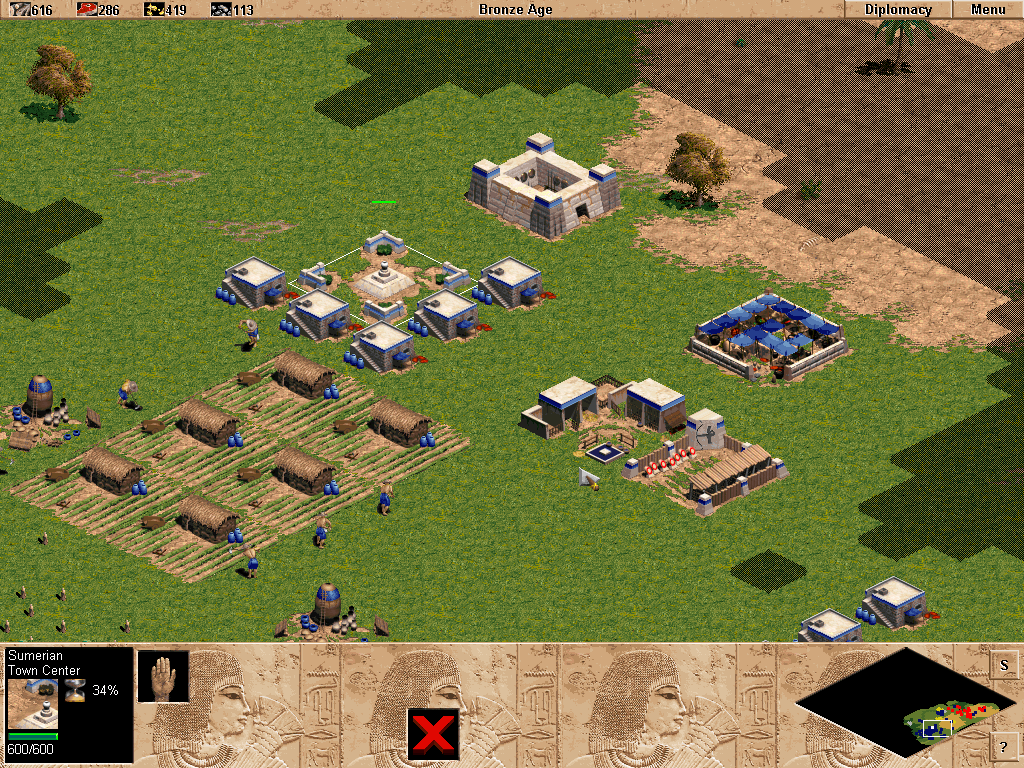
In general, the game has become an evolution of Red Alert and Warcraft II .

Seven Kingdoms: Ancient Adversaries lost amid the popularity of AoE .
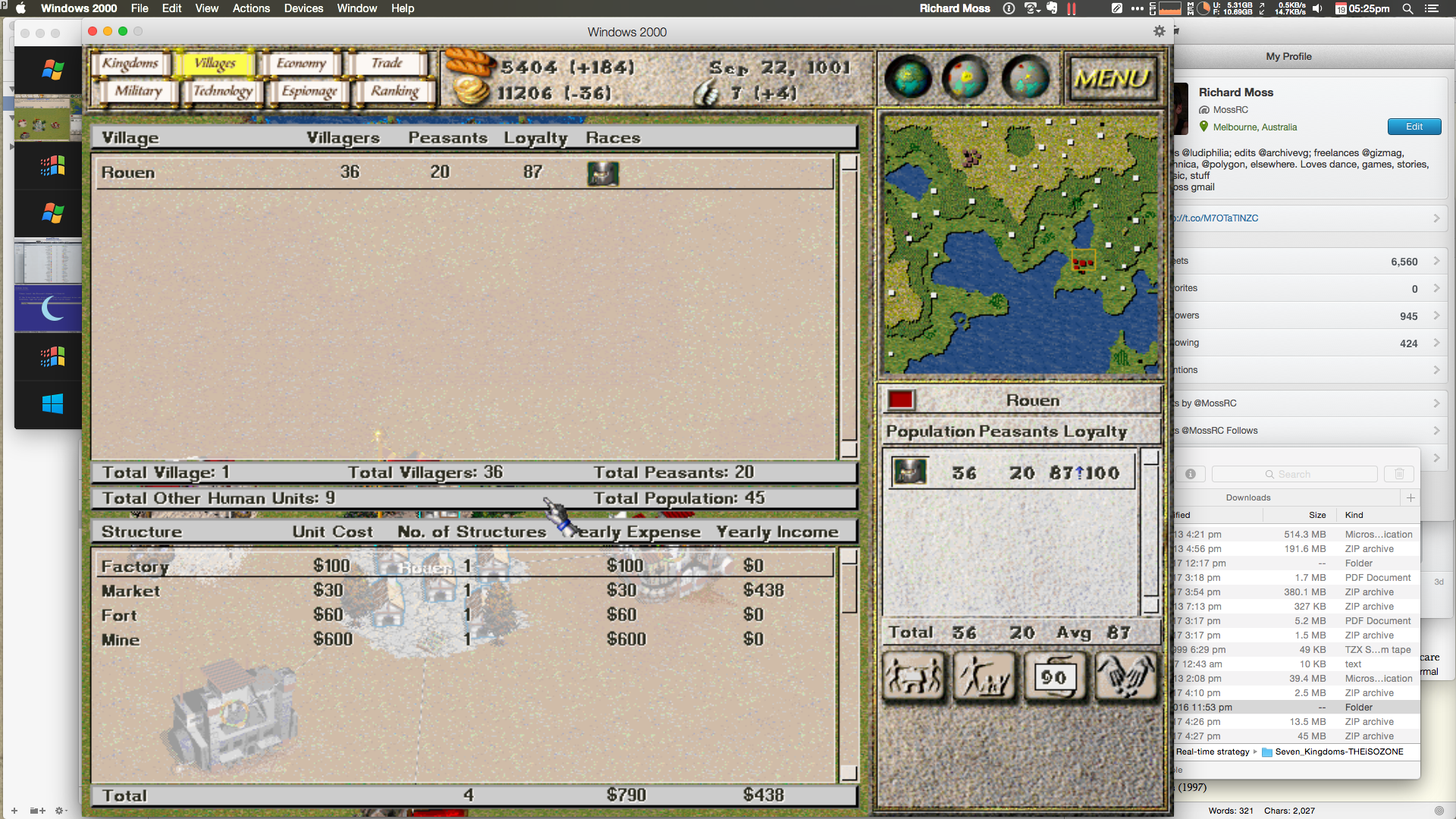
However, this game provided a much deeper strategy than was usual in RTS.

RTS fans finally managed to take a break from fantasy and science fiction in 1997, when two very different implementations of one basic idea appeared with an interval of just one month.
Under the direction of Bruce Shelley, co-author of Civilization, Ensemble Studios in October 1997 returned real-time strategy to the Stone Age (as well as to the Neolithic, Bronze and Iron Age) in its most popular hit Age of Empires . The player, who led one of the 12 unique real historical civilizations, had to spend his empire through four centuries, fighting with seven competing empires for dominance in the region. Like in Civilization, you can build monuments called “miracles” that give advantages (automatic victory in standard modes if it has been idle for more than 2000 years, or just a bonus to points in other modes). As in Civilization , the player must stimulate research in order to move to new technological discoveries before competitors.
In all other aspects, the game became an evolution of Red Alert and Warcraft II. The player has four resources, not two or three - stone, gold, wood and food (which could be grown, harvested from plants or obtained by hunting). The game has a more complex system of dependencies between upgrades and buildings. It also has diplomacy through receiving / giving offerings. The player could use navigation points to make the movement of units more strategic. But beneath the surface, Age of Empires had familiar cycles of resource collection, unit micromanagement, and base expansion.
Therefore, it is unfortunate that Seven Kingdoms: Ancient Adversaries , released just a month after Age of Empires , had such a small impact. Seven kingdomsDeveloped by the tiny Enlight Software company under the direction of designer and programmer Trevor Chan, creator of the highly regarded business simulator Capitalism , it was much better than can be decided on a modest schedule and mediocre sales. Her systems of diplomacy, trade and technology, of course, were not comparable to the systems of Civilization or a complex strategic game, for example, turn-based Imperialism . But in Seven Kingdoms there was a strategic depth inaccessible to conventional RTS.
Instead of thoughtlessly “clicking,” the player had to carefully (but quickly) think about maintaining equilibrium in the economy. Each unit and building had an annual service charge, charged after the creation costs, which had to be covered by taxing the peasants and trading in raw materials and processed resources in the markets. Each resident of any player-owned city automatically paid a small tax, but it was possible to get additional income by charging taxes repeatedly, although at the cost of reducing loyalty. Less loyal residents more easily fell under the influence of another civilization and were more likely to accept the bribe of an infiltrated spy.
Resources came from mines that were put on resource deposits, transferred to markets for sale and to factories for processing into goods that could also be sold in markets, if only the player assigned people to work in the respective buildings. Markets were harder than Age of Empires. The player needed to find the most efficient and profitable supply routes for caravans. It was necessary to ensure the availability of markets both in your kingdom and on the territory of competitors, that is, you had to enter into trade unions. If you make a mistake in this or stretch the forceful expansion of territories too much, it remains to rely only on taxes, which are unlikely to last long. This meant that life was never easy. As soon as the money ran out, the loyalty of the troops fell, the buildings collapsed, the siege weapons fell apart, and the villages passed to competitors. That's right - healthy leadership could lead to defeat in just 10 minutes.
To balance the detailed economic side of Seven Kingdomsalmost completely abandoned battle tactics. Victory in the battle ceased to depend on flanking maneuvers and a bunch of teams of units, in their place came throwing dice based on the size of the unit, the unit's combat skills (number from 10 to 100), the leadership skill of the general and the loyalty of each unit to the player. It was necessary to take into account nationality - joining a neutral or enemy city could have been much easier if most of the soldiers in the barracks on the edge of the city had the same nationality as the residents.

Dark Reign

Total Annihilation



Homeworld

Battle Scenes in in 3D!
Having lived for several years exclusively in 2D, the real-time strategy again began to flirt with a three-dimensional relief: in September 1997, Dark Reign: The Future of War was released . Graphically, Dark Reign was like existing games, but it used an internal height map that influenced the visibility of units. When the unit ascended the hill, he could see further. Moreover, when planning ambushes and setting off for reconnaissance, the player could use trees and stones as shelters.
The game introduced another convenient feature - the ability to turn off buildings at the base, which helped manage energy consumption. Units could be given orders to automatically research, attack, patrol, search and destroy, and even return to the base for repairs when a given level of damage was reached.
Total Annihilation , released just four weeks later, explored similar ideas. Its pre-rendered fixed-point 3D maps affected animations and unit visibility. The cards were tied to a physical engine that calculated the effects of explosions, artillery fire and the expansion of debris. But the game owed its triumph not to flirting with 3D. Rather, Total Annihilation has become a real master class in creating balance.
Energy was needed for everything: for building, creating units, mining metal (a scarce resource), and even for combat (unit weapons consumed energy). Start expanding too fast and production will be idle; build an army too large - it can remain without energy, defenseless even against a small group of attacking enemies. It was always necessary to keep track of the numbers, carefully monitor the balance of the income and expenditure of energy and metal (which, it is worth noting, could be collected from destroyed units). Oversupply meant inefficiency for which the player was punished, but a prolonged shortage could be even more threatening.
This need to think in terms of balance extended to the units themselves - each of them had a critical vulnerability that the other could take advantage of. The only unit able to cope with everyone else, the Commander, was also the only one whose loss was unacceptable - its destruction meant a loss.
A little later in 1997, Bungie's Myth , a terrific real-time 3D tactic, showed how a fully three-dimensional engine could improve the combat side of the RTS. Full control over the camera made it easier to view the battlefield, and weapons could become less effective and predictable (for example, grenades could roll and bounce) depending on the terrain.
But to catch up with the progress, the RTS games took another two years. The first 3D game wasHomeworld (1999), she was the first in outer space. Its structure was very reminiscent of the traditional RTS - we command the fleet, build ships, explore new technologies, collect resources - but the very nature of deep space themes strongly distinguishes the game from the standard surroundings of the genre. The need to think in three dimensions was sometimes confusing, especially with such a minimalistic interface, but it was well developed so as not to distract the player from the stunning, large-scale views.

You've probably already heard about it ...

StarCraft was much more than just a futuristic version of Warcraft .

While the first three-dimensional RTS appeared with grief in half, the traditional two-dimensional isometric perspective was able to secure a long life thanks to the most popular game of the genre. Having gained strength on the first two Warcraft and dungeon crawler's Diablo , Blizzard turned her attention to science fiction. Instead of orcs, people, elves and the like, fighting for wood, gold and oil, there were terrans (people), zerg and protoss fighting for minerals and gas in the distant world. StarCraft (1998) turned out to be much more than just a futuristic version of Warcraft. The most notable differences were the completely different three races. Their units, buildings, and resource extraction methods were unique, albeit roughly comparable. The balance of the races was ideal for their confrontation.
On the other hand, after the release of the game, there was one invincible strategy for the multiplayer mode: quickly create a large number of elementary units of the race, and then flood (“zarashit”) the enemy base before the enemy has time to build defense. (Zerg was most effective in this strategy due to the quickest creation of units, which is why the zerg rush meme arose.) Designers limited the players to a maximum of 12 units allocated simultaneously, but for a successful early rush they needed much less. Blizzard worked hard to fix such problems with balance, frequent patches changed the numbers inside the game, but with the correct implementation of the rush, they still remained a viable strategy. As is usually the case in online gaming circles, when one strategy becomes dominant,
It would be an omission on my part not to mention the enormous popularity of StarCraft in South Korea, where the game has become a mainstream cultural phenomenon. It led to the organization of television broadcasts and the creation of special channels, and this at a time when any mention of games on television was very rare. This widespread professional scene got its millionaire stars and gained full arena of spectators even a decade after the release of the game.

AoE II .

Honestly, she was more like AoE 1.5 .

Empire Earth .


In 1999, Ensemble Studios proposed a large-budget alternative to the sci-fi theme StarCraft in the face of the new historical RTS Age of Empires II: The Age of Kings . Although the game is better understood as Age of Empires 1.5 rather than a full-scale sequel, despite poor marketing and a decent sequel to a high price, it improved the original in the right ways. In addition, she added some great innovations.
The player could ring the bell of the town hall to call all the inhabitants to the village to protect the headquarters and meet the attacking arrows of hail. Groups of units actually kept their order while moving, the fastest units paused to wait for the laggards. In practice, this was important in many respects, but the most important was the effective protection of siege weapons and ranged units from attackers at close range, it allowed to counteract the excellent tactics and strategies of the enemies.
Such innovations brought AoE IIto the bestseller list, and yet there was a well-tuned random card generator and a qualitative balance of various winning strategies. Users continued to participate in multiplayer battles for many more years after the release of the game. (And some continue to this day: recent extensions to the HD re-release of the game were developed by fan community modders. They implemented balance improvements, “nerfed” strategies that became dominant at the beginning of this decade.)
Later, Empire Earth (2001) tried displace AoE IIfrom the throne of the main historical RTS: it contained 3D-graphics, a system of heroes, an improved AI, 14 historical epochs covering the entire history of mankind, and not just 4 eras stretching for 1000 years. But neither the impressive scale and complexity, nor the leadership of the leading designer of Age of Empires Rick Goodman could bring her sales and reviews closer to her spiritual predecessor.
Meanwhile, Westwood continued to go its own way, despite the fact that EA bought the studio and most of the key employees quit. A remake of Dune II called Dune 2000was released in 1998, right before the purchase of EA, and went unnoticed (because the new graphics did not reach the required level, the gameplay balance was absent, and the game itself tried to fix something that did not need to be fixed). The Command & Conquer: Tiberian Sun that followed in 1999 retained its signature, fun video clips and added all the expected improvements. In addition, an engine with dynamic lighting appeared in it, used for an excellent effect of searchlight towers (especially at night), and a high-quality system of waypoints with which patrol and movement routes could be set.
Prior to closure in early 2003, Westwood managed to release two more full-blown RTS games - Red Alert 2(2000), which was again deliberately made silly and funny, and Emperor: Battle for Dune (2001) is a high-quality and beautiful sequel to Dune II / Dune 2000 , the gameplay of which was very similar to the style of previous games.

Settlers III .

Cultures The .

Kohan .
On the periphery of the genre, everything was a little different. The Settlers III (1998) marked a new course for the charming Blue Byte strategy series on urban planning and supply chain management. Having got rid of roads and expanding combat capabilities, the game has become much more reminiscent of real-time strategy. But it still preserved dozens of different types of occupations for workers and almost as many primary and auxiliary resources that needed to be managed for the smooth development of your empire, protection against enemy attacks and the gradual conquest of the entire map. Cultures (2000)
had roughly the same spirit , and, without a doubt, the merit of its creators (Funatics Software), who studied the history of Settlers games, was in thisand who made the main goal of the game not conquest, but the happiness of a small tribe, which must be sought by research, construction and the economy. A similar approach was used by Anno 1602 (released in 1998 in Europe), it is 1602 AD (released in 2000 in the USA), which became the founder of another large series of games. The first part of Anno , like all subsequent games, considered the battle as a necessary hindrance to the main game process, which consisted in sea trade and research, as well as in the construction of colonies in the style of Settlers. It was unhurried and less time limited than most previous RTS games, and the war in it most often consisted of blockades and maneuvers than in real battles. However, the rather sophisticated economic model of Anno 1602 made the gameplay fun.
Released Kohan: Immortal Sovereigns(2001) demonstrated that the demand and consumption economy can actually be very viable in the RTS genre, which has traditionally emphasized defeating enemies with weapons. The player’s orders influenced the regiments, consisting of companies from a whole bunch of units of three different types under the command of the captain. It was possible to order companies to protect key points of the map, which provided defensive bonuses during long-term retention. When it came to the battle, the player could only watch, call for reinforcements or give orders to retreat (meaning a decrease in morale) and regroup.
Kohanalso simplified the collection of resources: everything except gold was obtained from resources located on the player’s territory. The surplus of resources could be directed to new units and population growth (which increased the territory of the city) or sold to receive gold, which was spent on maintenance (all have operating costs), upgrades, and covering the lack of resources for new companies or buildings. As in Seven Kingdoms , gold is always needed, otherwise you will see how your kingdom crumbles to dust.

Even with the decline of the RTS genre, remarkable games appeared ...

... like Majesty .

Cossacks .

WarCraft III came out just at the moment when MOBA began to gain mass popularity.


By the early 2000s, the love of RTS had declined. Publishers refused fast and low-quality clones of Command & Conquer , because the audience of real-time strategies narrowed down to a basic group of well-informed players who love online competitions and learned games from top to bottom. On the periphery there were groups that preferred single-player campaigns or niche RTS hybrids like Anno , Settlers and a series of serious Europa Universalis strategies .
Trying to reach these people, developers and publishers changed tactics: they aimed at an adjacent audience - RTS fans interested in any other genre with which it can mix, plus fans of other genres who are tolerant of RTS mechanics.
For example, Majesty: The Fantasy Kingdom Sim (2000) was essentially a modernized version of Stronghold (1993 version), but with completely autonomous units (which could be influenced by setting “reward” flags for tasks that they could go to heroes). Firefly's 2001 Stronghold RTS / Castle simulator partially added to the Age of Empires simplicity of the simulator and the sadistic pleasure of seeing boiling oil pouring through the wall onto a castle besieging infantry or from a farce comedy in which peasants carelessly entered a flaming building just to in a second to run out of it burning.
It is also worth remembering the Cossacks(2000), in which entire armies were grouped on the screen, grouped in different formations, each of which could contain up to 196 soldiers. Warrior Kings (2002) offered more creative and varied campaign missions than almost all the games before it, as well as large-scale (for that time) three-dimensional tactical battles. Celtic Kings (also 2002) became an RPG / RTS hybrid with separate adventure and strategy modes, each of which intertwined with another.
Big companies also experimented with new ideas. In Warcraft III: Reign of Chaos(2002) Blizzard added elements of RPG and special hero units. And with their help, she made the feedback loops much more intense. A pure “turtle” strategy (building a base and accumulating a large army before the first attack on the enemy) became risky, because in this case the level of heroes remained low. The game wanted the player to launch attacks and create patrol squads, and also stimulate him with the fact that the cards were populated by monsters, not very happy with the presence of the player and enemies in their territory.
If this sounds like MOBAs like Dota 2 and League of Legends , then don’t worry - that’s what it is. The MOBA genre originated in 2003 as a Warcraft III mod calledDefense of the Ancients , which itself was based on a fan map for StarCraft Aeon of Strife . (Note to the uninitiated: in essence, MOBA are RTS games without building / managing bases and directly controlling only hero units.)
But spinoffs were created not only by modders. Ensemble Studios took a break from its popular historical RTS series, releasing in 2002 the more story-driven and creative Age of Mythology . They cut the number of playable fractions from thirteen ( AoE II ) (18 with the Conquerers extension) to only three. Each of the races could choose one of three patron gods, giving certain bonuses. The process of obtaining the patronage of gods who were able to destroy enemies or send divine support was different for each of the civilizations, as well as the use of resources for construction. The skills with the habits of different classes of units also differed.
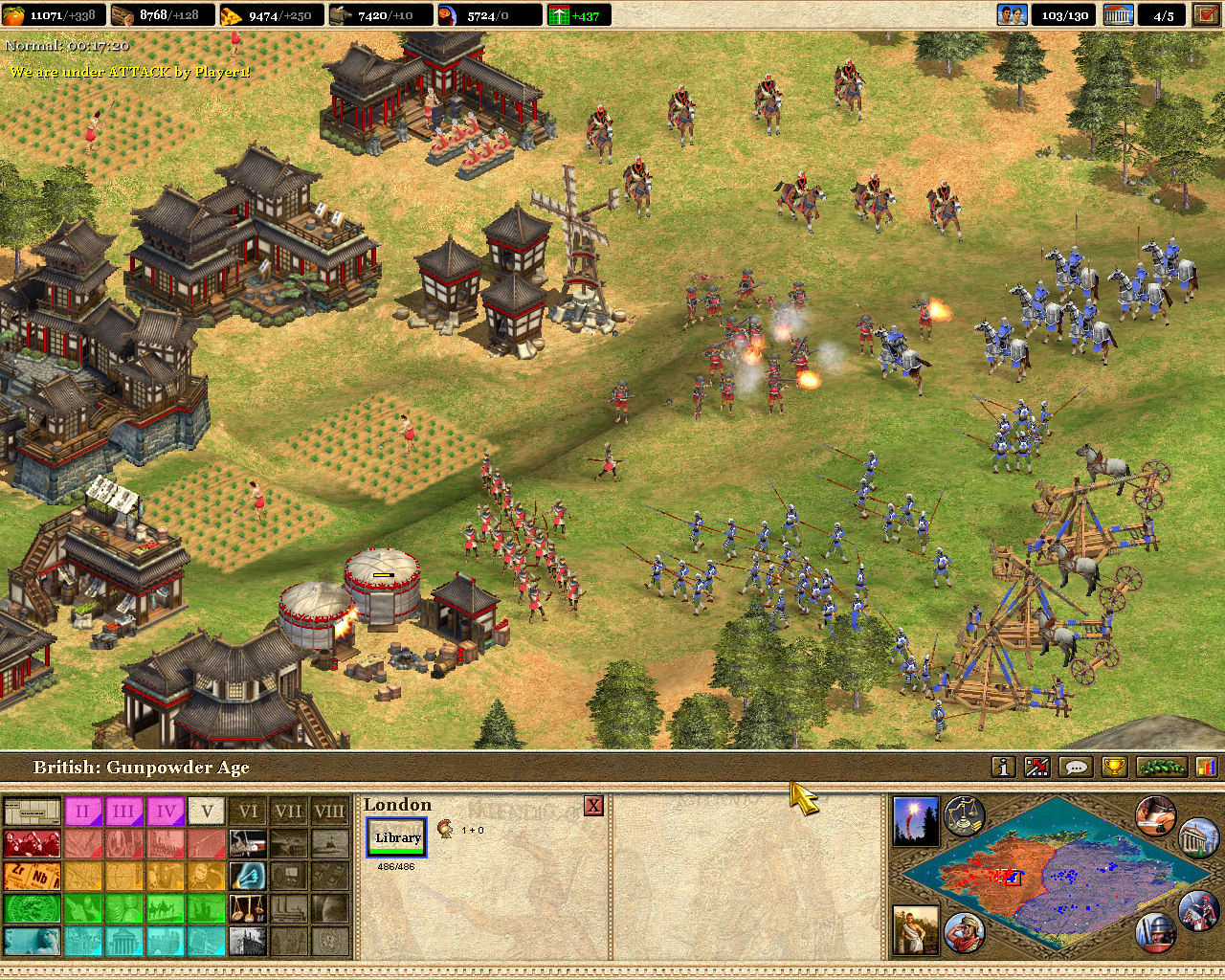
Perhaps Rise of Nations was the beginning of the end of the high-profile popularity of RTS.

Warhammer has proven that the genre is still alive.

Company of Heroes .

Flamethrower.
The first attempt to combine a traditional real-time strategy with a turn-based Civilization -style turn-based strategy was made only in 2003 - a macro and micro strategy combined in one ambitious game led by Brian Reynolds, lead designer of Civ II and Alpha Centauri . Rise of Nations at the same time became a breakthrough, a great step forward, and a dead end, a short-lived rebel of the strategic genre, highly valued and well-sold, and then gone into oblivion.
Its authors took the idea of territories and expanded it to full-blown cities within constantly moving national borders. The expansion of territories, on the one hand, is limited by progress in research in civil law - each level increases the development limit of the city by units, and on the other hand, by the complexity of conquests: being behind enemy lines, and therefore without direct reinforcements (if you do not take care of supply wagons), player units begin to suffer from combat losses.
As in Age of Empires with Empire Earth , in Rise of Nationsa large piece of the history of mankind is involved, but here the transitions between eras work a little better - they are more compressed, resource collection is automatic and there are “trading thresholds” to accelerate the pace of the game. This game was supposed to lead the player through the entire history of mankind in one hour, giving him an amazing sense of scale - you went from hoplites and catapults to archers, spearmen, guns, then to submarines, tanks and stealth bombers - the units were upgraded right before your eyes heading to battle with the enemy. The player also had access to the option of a threat with nuclear weapons that could refresh the later stages of the game: the explosion of each nuclear bomb brought Armageddon's clock hand closer to the cataclysm.
This may have indicated the growing fatigue from RTS that gradually emerged after the gold rush of the genre in the late 90s, but despite all the improvements and innovations, as well as impressive sales, Rise of Nations was unable to exert a strong influence on the genre. Real-time strategies were better than ever, and it seemed that they had a great future. However, this was the beginning of the end.
At that time it was not obvious. Against the backdrop of the successful (albeit too complicated) sequel, Homeworld Relic Entertainment has gained fame with the RTS version of the popular Warhammer 40k board game universe. In dawn of war(2004) the battle of space marines, orcs, eldar and demonic former paratroopers is masterfully transferred. DoW turned out to be a great game with excellent aesthetic and thematic elements. Most notably, it reinforced the idea that real-time strategy can focus on capturing and holding several strategic points on the way to an enemy fortress, rather than on attacks by warring bases.
Despite the abundance of tactical options that require constant attention, Dawn of Warallowed to maintain control over the game (to a greater extent), reducing the number of game units and focusing on managing squads, rather than individual units. But too often the gameplay was too fast, the shelter and fighting systems seemed ill-conceived, and all this proved that the RTS games were losing their accessibility - you had to remember too many hot keys and had to train too much before starting to compete in Multiplayer mode - the most interesting part of the game.
The next World War II-themed Relic, Company of Heroes (2006), takes on a new Dawn of War design templateand turned it into true innovation. In essence, it was a real-time tactical game, on top of which a strategic layer was laid. As in Dawn of War , strategic points were located on the maps, which after capture generated the resources necessary for special skills, upgrades, and training new units. But Company of Heroes developed this concept. Units could occupy any buildings and use them as shelters, and although the player could build military buildings to train new units, it was more important to keep existing structures.
Company of heroesconveyed the sensations of hostilities better than any other RTS before her. It was difficult not to become attached to your soldiers, because their screams pierced the battlefield, when powerful tanks rolled along the streets, destroying the player’s attack plans, and buildings and other map elements, for example, telephone lines, caught fire, collapsed and fell apart, posing new dangers for still living units. The infantry could be suppressed by enemy fire, and after some time so intimidated that it ceased to obey orders (except for the order to retreat). And despite all these minute-to-minute tactical nuances, it was a very strategic game. It was necessary to preserve supply routes, capture and hold not only strategic resource points, but also areas that give victory points, because war is a sequence of capture of small areas and difficult victories, and not the task of destroying an enemy base. It was just thatCompany of Heroes . AoE 3

sales were massive.

There is a reason why the studio still has an appetite for the release of AoE IV

Supreme Commander this fall .
The success of Age of Empires III (2005), the eighth best seller on the PC market in North America in 2005, suggested that real-time strategy still has a long life to do, even though it has barely changed in a decade. But hard times have come for PC gaming. Revenues from PC games have been falling throughout the industry every year since 2001, and now publishers have been wary of investing heavily. The console market looked more attractive, where sales grew rapidly . This has become a problem for real-time strategies: they always malfunctioned with console controllers. And no one wanted to take risks to rectify the situation.
Meanwhile, in the PC market, when Blizzard continued to stamp patches for StarCraftand Ensemble released two AoE III extensions , Total Annihilation designer Chris Taylor tried to destroy the impression of stagnation of the genre. He sought to reinvent RTS by reinforcing the strategic component and discarding the tactical complexity of the genre. Taylor released Supreme Commander (2007), the scale of the fighting which would not have allowed to fall into the trap of one-dimensional strategy and oversimplified tactics. The game cards were up to 6,500 square kilometers (2,500 square miles) in size and had a “strategic zoom” that allowed them to see the entire battlefield from outer space or from behind the unit.
A player could create lines from many teams and experiment with different approaches to the strategy of defeating the enemy - take it by number, sabotage or maneuvers on the flanks (the cards were so big that it turned out to be more interesting than usual) or something more inventive. The game provided more space for strategic thinking: is it worth trying to undermine the enemy’s economy? Target his missile systems and long-range units / bots / buildings? "Burrowing" into your own defense, preparing for a duel at the end of the mission?
Such considerations became even more interesting, given the unpredictability of the physical system (downed flying units could fall on your base, destroying part of it, or causing forest fires) and experimental units, for example, walking tanks or destroyers.
HoweverSupreme Commander fell into the same trap as all the real-time strategy games of that era: it was too difficult to learn to play. This, perhaps even more so than the stagnation of the RTS template itself, led to the decline of the genre, while other PC-specific ones began to gradually recover. Real-time strategies have crossed the threshold of complexity, which was tolerant for beginners.
Although in most RTS multiplayer battles, the focus was still focused on short battles, the participants of which figured out who can build more and faster - all in accordance with the roots of the genre - they required the player to learn so many hot keys, processes, rules and standard strategies (and all this had to be done quickly), then there simply wasn’t any sense in buying RTS if you weren’t ready to master all these skills or didn’t just want to go through the campaign mode (most likely, not completely polished).
Like urban simulators, stuck for several years in development after SimCity 4, and flight simulators (except those developed by fans), frozen after the advent of hardware acceleration of 3D graphics, slipping into an obsession with realism, the RTS genre collapsed. He cornered himself, striving for more elements that could be clicked, a larger set of memorable keyboard macros, more actions per minute (about 150 apm, that is 2.5 actions per second - that’s how much it takes to succeed in StarCraft II ), in other words, there is too much action in the action strategy. Despite the successes of the genre branch - MOBA and similar to the RTS tower defense, the RTS genre itself stood still.
Only sequels left - Supreme Commander 2(2010), coping with the difficulty too late, Red Alert 3 (2008), Dawn of War II (2009), Company of Heroes 2 (2013), StarCraft II (2015), and new Anno games , and Also, market share for the ever-popular oldies ( StarCraft , AoE II ), along with the latest Ensemble game of a difficult fate - Halo Wars (2009), which defeated problems with console management, but did not win success.

To be successful in StarCraft II, you need at least 150 apm, that is, 2.5 actions per second. O_o
The future of the real-time strategy genre looks vague. It is still of great interest, but it is difficult to assess how popular a quality game can turn out to be. Who is the most famous RTS-games are StarCraft II and of Age of Empires II of : first - an upgraded version of the 19-year-old game, the second - the very 18-year-old game (with the recent HD-remake and expansion). Relic's Company of Heroes and Dawn of War series still maintains a large amateur base among RTS players who prefer a large share of tactics in strategy. Are these players ready for something new and better?
Time will tell, although I can’t say when we will see the next excellent RTS. At the time of writing, only a few new games were announced , and none of them belong to a major studio. Tooth & Tail looks like a promising return to the roots of the RTS-deathmatch with a touch of modernity. Empires Apart openly admits being a new take on Age of Empires . Driftland: The Magic Revival hopes to conquer players with a combination of RTS and a god simulator. The historic open source RTS 0 AD looks promising, but has been in alpha for more than a decade. Chris Taylor is back with World of TanksWargaming and working on ... something .
However, I would not discount the genre so quickly. The PC game market is stronger than ever, so the real-time strategy can experience the same sudden renaissance as the adventure after Telltale heyday, or the urban development simulators after SimCity (2015), which paved the way for climbing to the top of Cities: Skylines .

The rise and fall of real-time strategies was very strange. They arose gradually from experiments in which developers tried to combine the speed and interest of action games with the deliberation and depth of strategies. Suddenly, the genre gained explosive popularity in the second half of the 90s, and then just as quickly lost it (with the exception of StarCraft ) in the mid-2000s, amid stagnation and changes in the game market. However, one of the most popular competitive games in the world is RTS, and the three of the four remaining are an offshoot of the real-time strategy genre.
At the age of 25, real-time strategies remain committed to their basic ideas and legacy. Today, at the moment of a deep lull of the genre, it's time to historically explore it, as we did with graphic adventure games , Sim games , first-person shooters , card races , open-world games ( translation into GT) and city-building simulators .
Before starting, I’ll explain: as in all studies of the history of genres, I want to highlight innovations and new ideas, that is, I can bypass some popular games and not mention at all [here is the name of your favorite game]. In this article, real-time strategy means the one in which the base is built and / or managed, the collection of resources, the production of units and semi-autonomous battles, and all this happens in real time (and not in turn-based mode). The aim of the game is to capture / hold strategic points of the map (for example, resources and command centers).
I also want to emphasize that tactics and strategy are not the same thing, and therefore in this article almost no tactical games in real time will be considered , for example, Total War and Close Combat. If you don’t know: strategy is high-level planning, and tactics are focused on smaller tasks. If to explain in terms of video games, the strategy is the construction and management of the armies created in the buildings with the help of the extracted / collected resources; tactics apply only to the battle itself and deep-seated combat mechanics, focused on the alignment and deployment of troops, the use of terrain features. RTS usually has an element of tactics, but tactical games rarely have strategic mechanics.
So, taking into account all of the above, let's begin the journey 36 years ago into the past.

If you recognize this game, then you have found the birth of the genre ( Utopia ).

Cytron Masters for Atari.

Perhaps the graphics are not impressive, but the mechanics of the game were advanced at that time.
Action connects with strategy
The separation of strategies into “real-time strategies” and “turn-based” strategies has been introduced relatively recently. Until the mid-90s, strategy games were turn-based, and action games were played in real time, and they never (well, almost never) combined. The game design was based on incompatible ideals: strategies inherited the rich traditions of complex and intricate desktop wargames; the action was a simple and thoughtless test of reflexes and coordination, they were based on arcade machines. The strategy was methodical and unhurried, dedicated to carefully planning and weighing each decision. The idea of adding real-time elements to force players to make instant, impulsive decisions was unheard of. Moreover, she seemed to be completely the opposite of strategy.
But it was at this time that Don Daglow created the highly influential 1981 Utopia game for Intellivision, which was one of the earliest predecessors of the real-time strategy genre. Utopia talked about the war of two island nations, in which it was necessary not only to penetrate the territory and / or destroy the enemy, but also to create their own reliable and prosperous base. It was necessary to think about the infrastructure, production, troops, weather, spies, pirates and the results of player decisions. As if it was not complicated enough, life on the islands and between them continued to boil even in the minutes of downtime - pirate raids, hurricanes, crop failure, riots and much more.
Soon, other “action-strategic" games appeared, each of which had its own view of how the two types of games should be combined. The next notable game was Cytron Masters (1982) from recognized designer Dan Bunten (later known as Daniel Bunten Berry). Bunten later said that the game "fell into the crevice" between the players in action and strategy. (Note: In 1992, Bunten changed sex and called himself Bunten Berry.)
Cytron Mastersthe gameplay resembled an early prototype of the RTS concept, but despite this, it failed commercially. The game had five semi-autonomous classes of units engaged in defense, attack and communication on the battlefield, several power sources that gave more energy (the only resource of the game) and allowed to build more units. The whole process took place on one screen. Players started the game on one of the edges of an area similar to a football field, but instead of the goal there were command centers. Players could see how the commands given by the adversary are executed in real time, along with their own.

Nether Earth

Robots \ m / appear in the RTS genre.

Modem Wars .

Stonkers .

Wargame for the ZX Spectrum Stonkers (1983) andChris Crawford's Legionnaire (1982) sought a more action-tactical style of play. The stripped-down quick adaptation of the combat phase of the traditional real-time wargame with beautiful Stonkers graphics was met with great enthusiasm, but many interfering game bugs negatively affected sales. Legionnaire , a simple semi-historical simulation of the battles of the Romans and the barbarians, received a more controversial trick. This game became the progenitor of the genre of real-time tactics (RTT), but he had to wait for popularity until next year. Then The Ancient Art of War appeared , a hit and influential computer wargame (RTT, like its closest relative RTS, took many years to finally become a recognized separate genre).
MeanwhileNether Earth (1987) further consolidated the basic concepts of what would later become RTS. In it, the player creates robots that can capture or destroy the six types of factories necessary for the manufacture of components used to produce even more robots. The ultimate goal of the game is to destroy the enemy’s base / bases, erasing them from the ground with the help of nuclear weapons aboard the kamikaze robot. The player can control the robots himself, choosing them one at a time, but usually it’s better to just give them orders to destroy, capture, kill or defend, and to focus on making new robots to surpass the enemy.
Another Dan Bunten Game Modem Wars(1988) put more emphasis on tactics, but possessed many of the elements that over time became critical in real-time strategies. Including the fog of war, which does not allow you to see enemy troops outside the scope of a unit / building, espionage, variable unit structures, the effect of terrain on movement and battle. The power-packed pace of the game made it possible to cope with many tasks without overloading the player (many of the later RTS were not able to learn this lesson).

Herzog Zwei

The player controls one of the fighting mechs, each of which can take air and ground forms, as well as carry different types of units. Units can be bought at the command center and give them orders.

Get it, player 1.

Powermonger for Amiga.

Click on objects and read descriptions.

Command HQ .

This game is similar to the RT adaptation of the classic Risk board game . It allows you to zoom in on the map and explore the cities of the country.
RTS in everything except the name
In the same year that Modem Wars came out , the tactical fur shooter Herzog of the Japanese Technosoft studio laid the foundation for what many consider the first real-time strategy game. After her in 1989, Sega Genesis released a prototype of MOBA (multiplayer online battle arena, the RTS offshoot genre) Herzog Zwei . In it, you control one of the fighting mechs that can transform between air and ground forms, as well as transfer different types of units that you can buy at the command center. You can order units to patrol, hold a position, attack / capture a satellite base, supply other units with supplies, or attack the enemy’s main base. Units try to complete these tasks with or without player assistance.
Nine satellite bases are scattered on the map, each of which can be captured with the help of four infantry units. Bases generate money, that is, they allow you to quickly release new units. In addition, bases can execute orders for the purchase of new units.
It was a difficult game, even despite the boring AI. Already at a low level of difficulty when playing against a computer, it instantly moves around, captures empty satellite bases, and then bumps into your main base with an endless crowd of units. Herzog zweiremained chaotic even when a player adjusted to her pace. When your units gained an advantage, the enemy could intervene with their fur and quickly destroy them if you do not support them with your own fur. But every second of participation in a battle is a time when you cannot buy new units, so the game turns into tedious exercises for quick micromanagement. Probably, the game foresaw the almost inevitable after StarCraft of the future multiplayer RTS - a world in which minor errors can have devastating consequences, and delay and power means a loss.
But at a time when the genre was just getting on its feet, the main task was to outline the basic mechanics, which varied greatly in different games. The next was Powermonger(1990) from the developer Populous Bullfrog, which almost redeemed its monotonous gameplay and stupid interface with interesting ideas. The game had a polygonal 3D map with the ability to scale and rotate, but limited to a small field of view. It had interconnected elements of simulation, such as wild animals, changing seasons and urban residents with their own activities that influenced the world (for example, there was less food in winter). The game was attended by interesting touches - in the cold, people basked near the fire, and after death turned into angels.
Also in the game there are three “build” armies that affect the execution of orders. Under suitable conditions, you can force all people from the conquered city to join your army, taking any available weapons, although it is often better to leave part of the inhabitants in place so they can work (thus providing you with the supply of resources for recruits if necessary).
Game Powermonger comes on the heels Command HQ Dan Bunt (1991), which appeared as an adaptation of the classic board game Riskin real time. It made the player scamper around the menu, managing the economy, helping foreign countries, studying intelligence reports, buying and placing units, setting targets for attacks, exploiting oil fields, launching space satellites and fighting in other world war simulations, from first to fifth. Sensible Software,
completely different in style and presentation, but equally ambitious on the scale of Mega Lo Mania (1991), stretched throughout the entire human history, divided into 10 eras. Like Powermonger , she lacked the tactical component of the battles, but she made up for it differently. At Mega Lo Maniathe player must assign people tasks: researching new technologies, collecting / extracting / processing the resources necessary to obtain better weapons, giving birth to new people or expanding the army. It was not only a technological, but also a territorial game in which the player had to send his troops to destroy enemy bases and / or build new fortresses in other areas. (There were different resources in each area, so sometimes it was necessary to reinvent / research the same technology.) The
uniqueness of the world and the small computer men made it possible to close our eyes to the shortcomings of Powermonger. Playing with small touches improved various aspects of the gameplay, except, it may be uninteresting and monotonous final phase. It is worth noting the beautiful voice samples transmitted with excellent intonation - “We've nuked them!” and the stereotypical “Do you want to be in my gang?”. In addition, after reaching a new era, buildings and people changed their appearance.

Dune II .

This game came out shortly after the original Dune , and both were very loosely connected to the film.

Of course, whoever controls the spice owns the Dune universe .

The North caused problems long before the era of Game of Thrones .
What's in the name?
Only in 1992 did real-time strategies gain their name thanks to Dune II producer Brett Sperry, who coined the term in an attempt to describe his game. From a design point of view, the Dune II was a little more than just an improvement on previous work, but their legacy and influence were evident throughout. Dune II is the first RTS game that people usually remember. This is a game that determined everything that arose after, both good, alas, and bad.
The developer of Westwood Studios, previously known for the most popular RPG Eye of the Beholder , when developing a superficially related to books and film Dune was very inspired by Herzog Zwei , the god simulator Populousand Macintosh GUI with mouse controls. Dune II , strangely released just a few months after the adventure game Dune Cryo Interactive, tells the simple story of House Atreides, House Harkonnen and invented by the developers of House Ordos, who are fighting for the control and use of spice on the planet Dune, because, as everyone knows, at least superficially familiar with the world of Dunes, the one who controls the spice controls the universe.
There is something undeniably exciting in the Dune II base gameplay- you send a harvester to collect spice, turn it into loans for which you can buy upgrades, repairs, new units and new buildings. A more convenient interface allowed less mess with micromanagement during attacks by enemies. This meant that the player had more time to study the map, create additional bases and think over strategies for destroying the enemy. During the game, you understand that with each passing minute, computer-controlled enemies also gather resources to improve the base and strengthen their army. This promised a long, exhausting battle for the capture of the map (it further worsened its need for a constant “click” to give orders separately to each unit, because there were no options for grouping or choosing several units).
Westwood took a feedback loop from the genre, which in the preliminary review of Computer Gaming World magazine's Master of Orion in 1993 would be named 4X (eXplore, eXpand, eXploit, eXterminate), and found a winning formula by changing the scale of the strategy from macro to micro level. In essence, each level was a small-scale 4X battle in real time.
The player always starts with a construction base, several hundred credits and a couple of units. Then, having restored its base after the attack (it is most convenient to do this by protecting at least one spice processing plant and mobile construction vehicles hidden in a safe place), he continued development - he created a second spice plant, ideally located near the distant spice field, monitored the enemy’s movements on a mini-map, built reliable (directed towards the enemy) perimeter defense away from the center of the base, sent trikes to look for weak spots in the enemy’s defense, at the last levels he built space sky port (because it is a cheaper and faster way to get the necessary tanks and missile launchers than a heavy machine factory). Another element of tension was the natural time limit - the amount of spice remaining. If you run out of spice before you win, then this is a sure sign of defeat. So modern RTS were born.

Maybe Dune II gave the name to the genre, but WarCraft stole it.

Not every game of the RTS genre of the DOS era could inspire the creation of a film adaptation.

V means Victory.

Everyone likes a good orc.
Then (then) the little-known studio Blizzard Entertainment consolidated the Dune II format as a new genre. Warcraft: Orcs and Humans (1994) replaced the sci-fi entourage Duneon old fashioned fantasy. Now the player did not collect spice to receive money, he mined gold and felled trees. Buildings were not built out of sight and were not exhibited instantly; they were built in front of the player’s eyes by unarmed peasants / peons, who also needed to be created (or, rather, “trained”).
In addition, the two warring races of Warcraft had their own personality. If Dune II’s Dom Harkonnen showed his villainous nature only with the destructive power of the Death Hand rocket, then the Warcraft orcswere charismatic and strangely attractive both in the game itself, where they answered the player’s orders with phrases, and in cutscenes between missions (a text scrolling with a comic voice acting against a static image), even when an orc girl was ordered to kill another orc (in order to “teach” her obey father).
In Warcraft, there was also a two-player battle mode for a local or Internet connection on maps used in the campaign or created procedurally. As the popularity of Doom defatch matches has changed first-person shooters, so the multi-user RTS mode has led to a gradual shift in development priorities. Warcraft Multiplayerwas popular and fascinated players even when they fully mastered the campaign for orcs and people. For Blizzard, this was an important lesson.

Command and Conquer .


The Cursed Brotherhood of Nod.

These are unforgettable videos.

Alert of Red .

The node and delightfully played video scenes are back.

What is the background of Red Alert ? The plot begins with the fact that Albert Einstein returns to the past to kill Hitler ...

Warcraft II .

The game added the mechanics of the fog of war, which made a great contribution to the RTS genre.
Reinforcements arrived
Westwood learned her own lessons from Dune II’s spiritual follower , Command & Conquer (1995), an exaggerated, frivolous view of the alien substance war between the Global Defense Initiative (GDI) and the Brotherhood of Nod, decentralized paramilitary secret community with deep corporate ties and almost cultist zeal.
At its core, Command & Conquer has become a faster version of Dune IItransferred to the alternative timeline of our world. It was supplemented by notable innovations - the choice of several units, support for multi-user mode and a logical interface. But one cannot stop on this description, otherwise we will neglect all the brilliance of other elements of the game. The deliberately pompous melodramatic cutscenes featuring live actors against the backdrop of green screens brought a bizarre fun to the dark theme of the game. It seemed that the GDI forces always act according to circumstances, the Brotherhood of Nod has become so cliched manic evil that it was impossible to resist laughing, watching their plans, betrayals and unjustified violence.
Nod’s troops readily kill defenseless inhabitants and destroy their homes, both during missions, if you do not defend the village, and in cutscenes. In one noteworthy mission for Nod, you are ordered to partake in the immoral philosophy of the Brotherhood: steal a GDI helicopter and then destroy a nearby village. But all the fun does not go to only Nod soldiers: in the campaign for GDI there is an amazing mission, in you use the commando to wipe the enemy base off the face of the earth, by secretly setting up explosives around it. Commando became one of the coolest units in RTS, in particular, due to the fact that they accompanied their destructive and bloody actions with gloomy phrases like “I have a gift for you!” and "One left!" Command & Conquer
Seriestook its place in pop culture thanks to the 1996 spin-off in the theme of World War II Red Alert . He transferred the wonderful videos, the fast pace and the spirit of the 90s of the original game into an alternative story of the mid-20th century, which in some way even better matched the style. In some ways, it can be considered a prequel to the frivolous first game. The story begins with the fact that Albert Einstein is transferred back to the past and kills Hitler, and this leads to absurd consequences - the Soviet Union has its own views on the expansion of territories, therefore an alternative World War II begins in which you can participate on the side of the Allies or Soviets .
Of course, the Nod Brotherhood could not do without the Brotherhood either - its mysterious leader Kane takes part in backstage intrigues in the corridors of Soviet power. In the game, the Tips are not as sinister as the Nod forces in C&C , but they can still please sadists thanks to weapons like Tesla’s coil, which can instantly fry any unit that’s unlucky to be in its field of action. Red alertIt is also noteworthy that the differences between the warring parties have intensified - the Soviet and Allied units differ more in skills and capabilities than the strength of Nod and GDI, despite the fact that at that time the trends in game development went in a different direction. However, the developers didn’t implement this quite correctly, so instead of taking advantage of variability and variety, ambitious players quickly found the dominant strategy: play for the Soviets, build a lot of heavy tanks, and then arrange a “rush” at the enemy’s base.
At the same time, Blizzard consolidated the success of Warcraft with the sequel to Warcraft II: Tides of Darkness (1995) with improved graphics and controls. Now the player could select several units in the same frame as in Command & Conquer, and the indicators and capabilities of the selected unit were visible at a glance. An added convenience was that the player could choose whether units should hold positions, chase attackers or patrol territory. Also in Warcraft II there was a deeper plot, in addition, for the first time in the genre, the game added a two-level fog of war system: not only unexplored areas were covered by black fog hiding everything, but areas outside the visibility of the player’s units and buildings (or his allies) were obscured grayed out. The player could still see the terrain, but not the enemy actions hidden by this fog.
The mechanics of the improved fog of war have changed the face of the genre. It meant that you could never have complete information about your enemies, which added many new levels of strategy. Now it was possible to suddenly make stealth attacks, fast and farsighted units could be used as scouts after the initial stage of the map research. And if the enemy is careless in intelligence, then you can accumulate large reserves of units hidden from his view, and then lure him into a trap. RTS games were still competition in click speed, but this innovation showed that they are beginning to justify the word "strategy" in their name.
After two hit Warcraft games and the resounding success of the three RTS Westwood, gateways opened - real-time strategies got into trends. And hordes of clones appeared.

After the appearance of excellent RTS, which attracted the attention of players, the creation of mediocre games was only a matter of time ...

such as Dark Colony ...

... or Earth 2140 .

Conquest Earth .

The best example from this stream of the second half of the 90s was Z (pronounced “zed”).

The game had a single tempo option - swift. It was a continuous crazy sequence of quick ups and downs in the battles for domination.
In this emerging abundance of mediocre science-fiction RTS Conquest Earth(1997) stood out because it allowed the race of Jupiterians attacking the Earth to disguise themselves as map objects, human transport, and also combine several weak units into one powerful one. Released in the same year, Dark Colony included a hero-like unit commander and mystical artifacts that could be captured to gain an advantage in battle. For example, you could turn surrounding trees into weapons or suck enemies into a tiny black hole. In Earth 2140 , also released in 1997, generals appeared who had special skills in managing and organizing groups of units, but they were so stupid that they turned out to be a burden rather than an advantage.
The legendary British studio The Bitmap Brothers, which was adored by Amiga fans for games of the late 80s and early 90s, managed to stand out from its competitors thanks to the 1996 game Z (pronounced "zed"). Instead of cultists with megalomania or warring races, the game told the story of armies of space-traveling robots programmed to battle to the last for control of five planets. The game added to the genre of British eccentricity, combining the humor of projects such as Mega Lo Mania and Powermonger with the irony that arose over the previous few years of the development of RTS.
Zbecame one of the first RTS games in which there was nothing superfluous. There is no slow construction, no temporary lull in the middle of the game, no tedious battles at the end of the level - only a constant crazy series of quick ups and downs in the struggle for domination. It was a game about territory control with simplified systems for collecting resources and managing bases. Their place was taken by control zones: the card is divided into cells, and the game itself resembles the RTS version of the “flag capture”. It was a modernized and improved Nether Earth , and it contained interesting ideas, for example, knocking out enemy troops from vehicles so that they could be occupied by their own soldiers. The game was proof that RTS games could go the other way, but even Z couldn’t change the trajectory given to the genreDune II .

Behold the treasure - the original Age of Empires .

AoE has borrowed some of its core concepts from Civilization .

In general, the game has become an evolution of Red Alert and Warcraft II .

Seven Kingdoms: Ancient Adversaries lost amid the popularity of AoE .

However, this game provided a much deeper strategy than was usual in RTS.

I need a stone
RTS fans finally managed to take a break from fantasy and science fiction in 1997, when two very different implementations of one basic idea appeared with an interval of just one month.
Under the direction of Bruce Shelley, co-author of Civilization, Ensemble Studios in October 1997 returned real-time strategy to the Stone Age (as well as to the Neolithic, Bronze and Iron Age) in its most popular hit Age of Empires . The player, who led one of the 12 unique real historical civilizations, had to spend his empire through four centuries, fighting with seven competing empires for dominance in the region. Like in Civilization, you can build monuments called “miracles” that give advantages (automatic victory in standard modes if it has been idle for more than 2000 years, or just a bonus to points in other modes). As in Civilization , the player must stimulate research in order to move to new technological discoveries before competitors.
In all other aspects, the game became an evolution of Red Alert and Warcraft II. The player has four resources, not two or three - stone, gold, wood and food (which could be grown, harvested from plants or obtained by hunting). The game has a more complex system of dependencies between upgrades and buildings. It also has diplomacy through receiving / giving offerings. The player could use navigation points to make the movement of units more strategic. But beneath the surface, Age of Empires had familiar cycles of resource collection, unit micromanagement, and base expansion.
Therefore, it is unfortunate that Seven Kingdoms: Ancient Adversaries , released just a month after Age of Empires , had such a small impact. Seven kingdomsDeveloped by the tiny Enlight Software company under the direction of designer and programmer Trevor Chan, creator of the highly regarded business simulator Capitalism , it was much better than can be decided on a modest schedule and mediocre sales. Her systems of diplomacy, trade and technology, of course, were not comparable to the systems of Civilization or a complex strategic game, for example, turn-based Imperialism . But in Seven Kingdoms there was a strategic depth inaccessible to conventional RTS.
Instead of thoughtlessly “clicking,” the player had to carefully (but quickly) think about maintaining equilibrium in the economy. Each unit and building had an annual service charge, charged after the creation costs, which had to be covered by taxing the peasants and trading in raw materials and processed resources in the markets. Each resident of any player-owned city automatically paid a small tax, but it was possible to get additional income by charging taxes repeatedly, although at the cost of reducing loyalty. Less loyal residents more easily fell under the influence of another civilization and were more likely to accept the bribe of an infiltrated spy.
Resources came from mines that were put on resource deposits, transferred to markets for sale and to factories for processing into goods that could also be sold in markets, if only the player assigned people to work in the respective buildings. Markets were harder than Age of Empires. The player needed to find the most efficient and profitable supply routes for caravans. It was necessary to ensure the availability of markets both in your kingdom and on the territory of competitors, that is, you had to enter into trade unions. If you make a mistake in this or stretch the forceful expansion of territories too much, it remains to rely only on taxes, which are unlikely to last long. This meant that life was never easy. As soon as the money ran out, the loyalty of the troops fell, the buildings collapsed, the siege weapons fell apart, and the villages passed to competitors. That's right - healthy leadership could lead to defeat in just 10 minutes.
To balance the detailed economic side of Seven Kingdomsalmost completely abandoned battle tactics. Victory in the battle ceased to depend on flanking maneuvers and a bunch of teams of units, in their place came throwing dice based on the size of the unit, the unit's combat skills (number from 10 to 100), the leadership skill of the general and the loyalty of each unit to the player. It was necessary to take into account nationality - joining a neutral or enemy city could have been much easier if most of the soldiers in the barracks on the edge of the city had the same nationality as the residents.

Dark Reign

Total Annihilation



Homeworld

Battle Scenes in in 3D!
Third dimension
Having lived for several years exclusively in 2D, the real-time strategy again began to flirt with a three-dimensional relief: in September 1997, Dark Reign: The Future of War was released . Graphically, Dark Reign was like existing games, but it used an internal height map that influenced the visibility of units. When the unit ascended the hill, he could see further. Moreover, when planning ambushes and setting off for reconnaissance, the player could use trees and stones as shelters.
The game introduced another convenient feature - the ability to turn off buildings at the base, which helped manage energy consumption. Units could be given orders to automatically research, attack, patrol, search and destroy, and even return to the base for repairs when a given level of damage was reached.
Total Annihilation , released just four weeks later, explored similar ideas. Its pre-rendered fixed-point 3D maps affected animations and unit visibility. The cards were tied to a physical engine that calculated the effects of explosions, artillery fire and the expansion of debris. But the game owed its triumph not to flirting with 3D. Rather, Total Annihilation has become a real master class in creating balance.
Energy was needed for everything: for building, creating units, mining metal (a scarce resource), and even for combat (unit weapons consumed energy). Start expanding too fast and production will be idle; build an army too large - it can remain without energy, defenseless even against a small group of attacking enemies. It was always necessary to keep track of the numbers, carefully monitor the balance of the income and expenditure of energy and metal (which, it is worth noting, could be collected from destroyed units). Oversupply meant inefficiency for which the player was punished, but a prolonged shortage could be even more threatening.
This need to think in terms of balance extended to the units themselves - each of them had a critical vulnerability that the other could take advantage of. The only unit able to cope with everyone else, the Commander, was also the only one whose loss was unacceptable - its destruction meant a loss.
A little later in 1997, Bungie's Myth , a terrific real-time 3D tactic, showed how a fully three-dimensional engine could improve the combat side of the RTS. Full control over the camera made it easier to view the battlefield, and weapons could become less effective and predictable (for example, grenades could roll and bounce) depending on the terrain.
But to catch up with the progress, the RTS games took another two years. The first 3D game wasHomeworld (1999), she was the first in outer space. Its structure was very reminiscent of the traditional RTS - we command the fleet, build ships, explore new technologies, collect resources - but the very nature of deep space themes strongly distinguishes the game from the standard surroundings of the genre. The need to think in three dimensions was sometimes confusing, especially with such a minimalistic interface, but it was well developed so as not to distract the player from the stunning, large-scale views.

You've probably already heard about it ...

StarCraft was much more than just a futuristic version of Warcraft .

Zerg rush
While the first three-dimensional RTS appeared with grief in half, the traditional two-dimensional isometric perspective was able to secure a long life thanks to the most popular game of the genre. Having gained strength on the first two Warcraft and dungeon crawler's Diablo , Blizzard turned her attention to science fiction. Instead of orcs, people, elves and the like, fighting for wood, gold and oil, there were terrans (people), zerg and protoss fighting for minerals and gas in the distant world. StarCraft (1998) turned out to be much more than just a futuristic version of Warcraft. The most notable differences were the completely different three races. Their units, buildings, and resource extraction methods were unique, albeit roughly comparable. The balance of the races was ideal for their confrontation.
On the other hand, after the release of the game, there was one invincible strategy for the multiplayer mode: quickly create a large number of elementary units of the race, and then flood (“zarashit”) the enemy base before the enemy has time to build defense. (Zerg was most effective in this strategy due to the quickest creation of units, which is why the zerg rush meme arose.) Designers limited the players to a maximum of 12 units allocated simultaneously, but for a successful early rush they needed much less. Blizzard worked hard to fix such problems with balance, frequent patches changed the numbers inside the game, but with the correct implementation of the rush, they still remained a viable strategy. As is usually the case in online gaming circles, when one strategy becomes dominant,
It would be an omission on my part not to mention the enormous popularity of StarCraft in South Korea, where the game has become a mainstream cultural phenomenon. It led to the organization of television broadcasts and the creation of special channels, and this at a time when any mention of games on television was very rare. This widespread professional scene got its millionaire stars and gained full arena of spectators even a decade after the release of the game.

AoE II .

Honestly, she was more like AoE 1.5 .

Empire Earth .


Consolidation
In 1999, Ensemble Studios proposed a large-budget alternative to the sci-fi theme StarCraft in the face of the new historical RTS Age of Empires II: The Age of Kings . Although the game is better understood as Age of Empires 1.5 rather than a full-scale sequel, despite poor marketing and a decent sequel to a high price, it improved the original in the right ways. In addition, she added some great innovations.
The player could ring the bell of the town hall to call all the inhabitants to the village to protect the headquarters and meet the attacking arrows of hail. Groups of units actually kept their order while moving, the fastest units paused to wait for the laggards. In practice, this was important in many respects, but the most important was the effective protection of siege weapons and ranged units from attackers at close range, it allowed to counteract the excellent tactics and strategies of the enemies.
Such innovations brought AoE IIto the bestseller list, and yet there was a well-tuned random card generator and a qualitative balance of various winning strategies. Users continued to participate in multiplayer battles for many more years after the release of the game. (And some continue to this day: recent extensions to the HD re-release of the game were developed by fan community modders. They implemented balance improvements, “nerfed” strategies that became dominant at the beginning of this decade.)
Later, Empire Earth (2001) tried displace AoE IIfrom the throne of the main historical RTS: it contained 3D-graphics, a system of heroes, an improved AI, 14 historical epochs covering the entire history of mankind, and not just 4 eras stretching for 1000 years. But neither the impressive scale and complexity, nor the leadership of the leading designer of Age of Empires Rick Goodman could bring her sales and reviews closer to her spiritual predecessor.
Meanwhile, Westwood continued to go its own way, despite the fact that EA bought the studio and most of the key employees quit. A remake of Dune II called Dune 2000was released in 1998, right before the purchase of EA, and went unnoticed (because the new graphics did not reach the required level, the gameplay balance was absent, and the game itself tried to fix something that did not need to be fixed). The Command & Conquer: Tiberian Sun that followed in 1999 retained its signature, fun video clips and added all the expected improvements. In addition, an engine with dynamic lighting appeared in it, used for an excellent effect of searchlight towers (especially at night), and a high-quality system of waypoints with which patrol and movement routes could be set.
Prior to closure in early 2003, Westwood managed to release two more full-blown RTS games - Red Alert 2(2000), which was again deliberately made silly and funny, and Emperor: Battle for Dune (2001) is a high-quality and beautiful sequel to Dune II / Dune 2000 , the gameplay of which was very similar to the style of previous games.

Settlers III .

Cultures The .

Kohan .
In the rear
On the periphery of the genre, everything was a little different. The Settlers III (1998) marked a new course for the charming Blue Byte strategy series on urban planning and supply chain management. Having got rid of roads and expanding combat capabilities, the game has become much more reminiscent of real-time strategy. But it still preserved dozens of different types of occupations for workers and almost as many primary and auxiliary resources that needed to be managed for the smooth development of your empire, protection against enemy attacks and the gradual conquest of the entire map. Cultures (2000)
had roughly the same spirit , and, without a doubt, the merit of its creators (Funatics Software), who studied the history of Settlers games, was in thisand who made the main goal of the game not conquest, but the happiness of a small tribe, which must be sought by research, construction and the economy. A similar approach was used by Anno 1602 (released in 1998 in Europe), it is 1602 AD (released in 2000 in the USA), which became the founder of another large series of games. The first part of Anno , like all subsequent games, considered the battle as a necessary hindrance to the main game process, which consisted in sea trade and research, as well as in the construction of colonies in the style of Settlers. It was unhurried and less time limited than most previous RTS games, and the war in it most often consisted of blockades and maneuvers than in real battles. However, the rather sophisticated economic model of Anno 1602 made the gameplay fun.
Released Kohan: Immortal Sovereigns(2001) demonstrated that the demand and consumption economy can actually be very viable in the RTS genre, which has traditionally emphasized defeating enemies with weapons. The player’s orders influenced the regiments, consisting of companies from a whole bunch of units of three different types under the command of the captain. It was possible to order companies to protect key points of the map, which provided defensive bonuses during long-term retention. When it came to the battle, the player could only watch, call for reinforcements or give orders to retreat (meaning a decrease in morale) and regroup.
Kohanalso simplified the collection of resources: everything except gold was obtained from resources located on the player’s territory. The surplus of resources could be directed to new units and population growth (which increased the territory of the city) or sold to receive gold, which was spent on maintenance (all have operating costs), upgrades, and covering the lack of resources for new companies or buildings. As in Seven Kingdoms , gold is always needed, otherwise you will see how your kingdom crumbles to dust.

Even with the decline of the RTS genre, remarkable games appeared ...

... like Majesty .

Cossacks .

WarCraft III came out just at the moment when MOBA began to gain mass popularity.


Hybridization
By the early 2000s, the love of RTS had declined. Publishers refused fast and low-quality clones of Command & Conquer , because the audience of real-time strategies narrowed down to a basic group of well-informed players who love online competitions and learned games from top to bottom. On the periphery there were groups that preferred single-player campaigns or niche RTS hybrids like Anno , Settlers and a series of serious Europa Universalis strategies .
Trying to reach these people, developers and publishers changed tactics: they aimed at an adjacent audience - RTS fans interested in any other genre with which it can mix, plus fans of other genres who are tolerant of RTS mechanics.
For example, Majesty: The Fantasy Kingdom Sim (2000) was essentially a modernized version of Stronghold (1993 version), but with completely autonomous units (which could be influenced by setting “reward” flags for tasks that they could go to heroes). Firefly's 2001 Stronghold RTS / Castle simulator partially added to the Age of Empires simplicity of the simulator and the sadistic pleasure of seeing boiling oil pouring through the wall onto a castle besieging infantry or from a farce comedy in which peasants carelessly entered a flaming building just to in a second to run out of it burning.
It is also worth remembering the Cossacks(2000), in which entire armies were grouped on the screen, grouped in different formations, each of which could contain up to 196 soldiers. Warrior Kings (2002) offered more creative and varied campaign missions than almost all the games before it, as well as large-scale (for that time) three-dimensional tactical battles. Celtic Kings (also 2002) became an RPG / RTS hybrid with separate adventure and strategy modes, each of which intertwined with another.
Big companies also experimented with new ideas. In Warcraft III: Reign of Chaos(2002) Blizzard added elements of RPG and special hero units. And with their help, she made the feedback loops much more intense. A pure “turtle” strategy (building a base and accumulating a large army before the first attack on the enemy) became risky, because in this case the level of heroes remained low. The game wanted the player to launch attacks and create patrol squads, and also stimulate him with the fact that the cards were populated by monsters, not very happy with the presence of the player and enemies in their territory.
If this sounds like MOBAs like Dota 2 and League of Legends , then don’t worry - that’s what it is. The MOBA genre originated in 2003 as a Warcraft III mod calledDefense of the Ancients , which itself was based on a fan map for StarCraft Aeon of Strife . (Note to the uninitiated: in essence, MOBA are RTS games without building / managing bases and directly controlling only hero units.)
But spinoffs were created not only by modders. Ensemble Studios took a break from its popular historical RTS series, releasing in 2002 the more story-driven and creative Age of Mythology . They cut the number of playable fractions from thirteen ( AoE II ) (18 with the Conquerers extension) to only three. Each of the races could choose one of three patron gods, giving certain bonuses. The process of obtaining the patronage of gods who were able to destroy enemies or send divine support was different for each of the civilizations, as well as the use of resources for construction. The skills with the habits of different classes of units also differed.

Perhaps Rise of Nations was the beginning of the end of the high-profile popularity of RTS.

Warhammer has proven that the genre is still alive.

Company of Heroes .

Flamethrower.
Last hit
The first attempt to combine a traditional real-time strategy with a turn-based Civilization -style turn-based strategy was made only in 2003 - a macro and micro strategy combined in one ambitious game led by Brian Reynolds, lead designer of Civ II and Alpha Centauri . Rise of Nations at the same time became a breakthrough, a great step forward, and a dead end, a short-lived rebel of the strategic genre, highly valued and well-sold, and then gone into oblivion.
Its authors took the idea of territories and expanded it to full-blown cities within constantly moving national borders. The expansion of territories, on the one hand, is limited by progress in research in civil law - each level increases the development limit of the city by units, and on the other hand, by the complexity of conquests: being behind enemy lines, and therefore without direct reinforcements (if you do not take care of supply wagons), player units begin to suffer from combat losses.
As in Age of Empires with Empire Earth , in Rise of Nationsa large piece of the history of mankind is involved, but here the transitions between eras work a little better - they are more compressed, resource collection is automatic and there are “trading thresholds” to accelerate the pace of the game. This game was supposed to lead the player through the entire history of mankind in one hour, giving him an amazing sense of scale - you went from hoplites and catapults to archers, spearmen, guns, then to submarines, tanks and stealth bombers - the units were upgraded right before your eyes heading to battle with the enemy. The player also had access to the option of a threat with nuclear weapons that could refresh the later stages of the game: the explosion of each nuclear bomb brought Armageddon's clock hand closer to the cataclysm.
This may have indicated the growing fatigue from RTS that gradually emerged after the gold rush of the genre in the late 90s, but despite all the improvements and innovations, as well as impressive sales, Rise of Nations was unable to exert a strong influence on the genre. Real-time strategies were better than ever, and it seemed that they had a great future. However, this was the beginning of the end.
At that time it was not obvious. Against the backdrop of the successful (albeit too complicated) sequel, Homeworld Relic Entertainment has gained fame with the RTS version of the popular Warhammer 40k board game universe. In dawn of war(2004) the battle of space marines, orcs, eldar and demonic former paratroopers is masterfully transferred. DoW turned out to be a great game with excellent aesthetic and thematic elements. Most notably, it reinforced the idea that real-time strategy can focus on capturing and holding several strategic points on the way to an enemy fortress, rather than on attacks by warring bases.
Despite the abundance of tactical options that require constant attention, Dawn of Warallowed to maintain control over the game (to a greater extent), reducing the number of game units and focusing on managing squads, rather than individual units. But too often the gameplay was too fast, the shelter and fighting systems seemed ill-conceived, and all this proved that the RTS games were losing their accessibility - you had to remember too many hot keys and had to train too much before starting to compete in Multiplayer mode - the most interesting part of the game.
The next World War II-themed Relic, Company of Heroes (2006), takes on a new Dawn of War design templateand turned it into true innovation. In essence, it was a real-time tactical game, on top of which a strategic layer was laid. As in Dawn of War , strategic points were located on the maps, which after capture generated the resources necessary for special skills, upgrades, and training new units. But Company of Heroes developed this concept. Units could occupy any buildings and use them as shelters, and although the player could build military buildings to train new units, it was more important to keep existing structures.
Company of heroesconveyed the sensations of hostilities better than any other RTS before her. It was difficult not to become attached to your soldiers, because their screams pierced the battlefield, when powerful tanks rolled along the streets, destroying the player’s attack plans, and buildings and other map elements, for example, telephone lines, caught fire, collapsed and fell apart, posing new dangers for still living units. The infantry could be suppressed by enemy fire, and after some time so intimidated that it ceased to obey orders (except for the order to retreat). And despite all these minute-to-minute tactical nuances, it was a very strategic game. It was necessary to preserve supply routes, capture and hold not only strategic resource points, but also areas that give victory points, because war is a sequence of capture of small areas and difficult victories, and not the task of destroying an enemy base. It was just thatCompany of Heroes . AoE 3

sales were massive.

There is a reason why the studio still has an appetite for the release of AoE IV

Supreme Commander this fall .
Decline
The success of Age of Empires III (2005), the eighth best seller on the PC market in North America in 2005, suggested that real-time strategy still has a long life to do, even though it has barely changed in a decade. But hard times have come for PC gaming. Revenues from PC games have been falling throughout the industry every year since 2001, and now publishers have been wary of investing heavily. The console market looked more attractive, where sales grew rapidly . This has become a problem for real-time strategies: they always malfunctioned with console controllers. And no one wanted to take risks to rectify the situation.
Meanwhile, in the PC market, when Blizzard continued to stamp patches for StarCraftand Ensemble released two AoE III extensions , Total Annihilation designer Chris Taylor tried to destroy the impression of stagnation of the genre. He sought to reinvent RTS by reinforcing the strategic component and discarding the tactical complexity of the genre. Taylor released Supreme Commander (2007), the scale of the fighting which would not have allowed to fall into the trap of one-dimensional strategy and oversimplified tactics. The game cards were up to 6,500 square kilometers (2,500 square miles) in size and had a “strategic zoom” that allowed them to see the entire battlefield from outer space or from behind the unit.
A player could create lines from many teams and experiment with different approaches to the strategy of defeating the enemy - take it by number, sabotage or maneuvers on the flanks (the cards were so big that it turned out to be more interesting than usual) or something more inventive. The game provided more space for strategic thinking: is it worth trying to undermine the enemy’s economy? Target his missile systems and long-range units / bots / buildings? "Burrowing" into your own defense, preparing for a duel at the end of the mission?
Such considerations became even more interesting, given the unpredictability of the physical system (downed flying units could fall on your base, destroying part of it, or causing forest fires) and experimental units, for example, walking tanks or destroyers.
HoweverSupreme Commander fell into the same trap as all the real-time strategy games of that era: it was too difficult to learn to play. This, perhaps even more so than the stagnation of the RTS template itself, led to the decline of the genre, while other PC-specific ones began to gradually recover. Real-time strategies have crossed the threshold of complexity, which was tolerant for beginners.
Although in most RTS multiplayer battles, the focus was still focused on short battles, the participants of which figured out who can build more and faster - all in accordance with the roots of the genre - they required the player to learn so many hot keys, processes, rules and standard strategies (and all this had to be done quickly), then there simply wasn’t any sense in buying RTS if you weren’t ready to master all these skills or didn’t just want to go through the campaign mode (most likely, not completely polished).
Like urban simulators, stuck for several years in development after SimCity 4, and flight simulators (except those developed by fans), frozen after the advent of hardware acceleration of 3D graphics, slipping into an obsession with realism, the RTS genre collapsed. He cornered himself, striving for more elements that could be clicked, a larger set of memorable keyboard macros, more actions per minute (about 150 apm, that is 2.5 actions per second - that’s how much it takes to succeed in StarCraft II ), in other words, there is too much action in the action strategy. Despite the successes of the genre branch - MOBA and similar to the RTS tower defense, the RTS genre itself stood still.
Only sequels left - Supreme Commander 2(2010), coping with the difficulty too late, Red Alert 3 (2008), Dawn of War II (2009), Company of Heroes 2 (2013), StarCraft II (2015), and new Anno games , and Also, market share for the ever-popular oldies ( StarCraft , AoE II ), along with the latest Ensemble game of a difficult fate - Halo Wars (2009), which defeated problems with console management, but did not win success.

To be successful in StarCraft II, you need at least 150 apm, that is, 2.5 actions per second. O_o
Let's move on!
The future of the real-time strategy genre looks vague. It is still of great interest, but it is difficult to assess how popular a quality game can turn out to be. Who is the most famous RTS-games are StarCraft II and of Age of Empires II of : first - an upgraded version of the 19-year-old game, the second - the very 18-year-old game (with the recent HD-remake and expansion). Relic's Company of Heroes and Dawn of War series still maintains a large amateur base among RTS players who prefer a large share of tactics in strategy. Are these players ready for something new and better?
Time will tell, although I can’t say when we will see the next excellent RTS. At the time of writing, only a few new games were announced , and none of them belong to a major studio. Tooth & Tail looks like a promising return to the roots of the RTS-deathmatch with a touch of modernity. Empires Apart openly admits being a new take on Age of Empires . Driftland: The Magic Revival hopes to conquer players with a combination of RTS and a god simulator. The historic open source RTS 0 AD looks promising, but has been in alpha for more than a decade. Chris Taylor is back with World of TanksWargaming and working on ... something .
However, I would not discount the genre so quickly. The PC game market is stronger than ever, so the real-time strategy can experience the same sudden renaissance as the adventure after Telltale heyday, or the urban development simulators after SimCity (2015), which paved the way for climbing to the top of Cities: Skylines .
